
Architect’s visionary stadium aims to keep Bears in Chicago
Honoring the city’s ‘make no little plans’ tradition, Larry Booth has sketched out a big-picture vision for what a stadium could look like within city limits
|
By Dennis Rodkin
Like a lot of people, Larry Booth has been mi ed by all the talk of the Chicago Bears moving to Arlington Heights or Naperville or Waukegan or some other town.
Unlike most of them, Booth is an architect who’s worked out a concept for a stadium that he believes would not only keep the team in Chicago but showcase the city’s history as a hub of architectural innovation.
“Keep them in Chicago,” says Booth, the eminent architect who’s been practicing in the city since the 1960s, designing dozens of new buildings and renovations of old ones, as well as more in the suburbs and farther a eld.
As such, Booth is uniquely quali ed to spitball a blue-sky vision


Ringed in wood, the 80,000-seat stadium would greatly reduce the carbon footprint compared to concrete and steel construction.
Is the DNC a trial run for a Pritzker White House bid?
Biden aside, no one has more riding on a successful event than the governor does
When President Joe Biden walks onto the stage at the United Center this summer for the 2024 Democratic National Convention, it will mark the beginning of the last act for a veteran politician.
For Illinois Gov. J.B. Pritzker, the stage he helped set in Chicago could also serve as his own on-ramp to the White House.
“ is convention is a great platform for Gov. Pritzker,” said David Yepsen, former director of the Paul Simon Public Policy Institute at Southern Illinois University. “ is is a chance for the governor to look good, show his stu , to be a good host, do a lot of schmoozing, and not just with delegates who are clear party inuencers, but also big donors. So it's tailor-made for him to use it as a springboard.”
In 2022, Pritzker served as the keynote speaker at the New Hampshire Democratic Party’s state convention, provoking speculation that he was mulling a White House bid. at chatter tempered as Biden a rmed he would run. Talk of a Pritzker presidential campaign bubbled up again last fall with the announcement of his new organization, ink Big America, which will contribute to e orts to expand abortion access in states

across the country.
Still, Pritzker understands how to serve as the happy warrior for Biden even as theories about his political ambitions persist, according to U.S. Rep. Jan Schakowsky, D-Evanston.
“ at’s something that J.B. will manage well,” said Schakowsky, who once competed with Pritzker for her House seat. “He knows what it is to be a surrogate. He has no intention of trying to outstrip the president of the United States.”
A DNC spokesperson declined to comment for this story. e convention bodes well for Pritzker, who has already elevated his national pro le with his work as a Biden campaign
No place like here
BARNES & NOBLE
The bookstore giant is opening a new store in Wicker Park as well as three other surrounding locations. PAGE 3

CRAIN’S LIST
Check out our ranking of the Chicago area’s 25 largest employers.
PAGE 13

CHICAGOBUSINESS.COM I FEBRUARY 26, 2024 VOL. 47, NO. 8 l COPYRIGHT 2024 CRAIN COMMUNICATIONS INC. l ALL RIGHTS RESERVED
CRAIN’S An affordable big city with deep pools of talent, Chicago needs to regain its edge as a place to do business | PAGE 15
BOOTH HANSEN
Leigh Giangreco
No one worked harder than the governor to bring the Democratic National Convention to Chicago. | BLOOMBERG
See PRITZKER on Page 24
See STADIUM on Page 26
Northwestern Medicine plans $75 million expansion of Warrenville cancer center
Northwestern Medicine is planning to expand and modernize a cancer center in Warrenville, a project estimated to cost more than $75 million.
e plan is to construct a twostory addition and a three-story parking garage to the existing Warrenville cancer center at 4405 Weaver Parkway, according to an application led Feb. 15 with the Illinois Health Facilities & Services Review Board, which has to approve the project.
Northwestern spokesman Chris King said the expansion is needed to meet growing oncology and diagnostic imaging services demand in the area. From 2018 to 2023, annual infusion hours at the center grew 44% to more than 50,000 hours and MRI procedures jumped 34% to nearly 3,000 annual procedures, according to the application.
More space would allow the center to increase infusion stations from 26 to 38, add additional diagnostic imaging and expand laboratory testing, King added.
If the plan is approved, the expansion is expected to be completed by the end of 2027, according to the application.
e Warrenville cancer center, a liated with the Robert H. Lurie Comprehensive Cancer Center of Northwestern University, treats various types of cancers, o ering medical, surgical, radiation oncology and other supportive services.
Has focused on expansion
Like its nearby peers, Northwestern Medicine, the area’s second-largest hospital system by
HCSC bets on Medicare
Insurers are sounding alarms about the state of the market. But that isn’t discouraging Health Care Service Corp. from expanding.
Lauren Berryman, Modern Healthcare
Financial and regulatory challenges in Medicare Advantage aren't stopping Health Care Service Corp. from diving deeper into its suddenly murky waters.
Industry leaders UnitedHealth Group and Humana, along with other carriers such as Centene, Molina Healthcare and CVS Health subsidiary Aetna, recently disclosed that their Medicare Advantage operations are under nancial strain amid higher-than-expected medical expenses, federal policies to constrain spending and promote quality, and a looming payment cut.
Yet HCSC, a nonpro t Blue Cross & Blue Shield carrier, announced plans last month to pay $3.3 billion for Cigna's Medicare operations. e acquisition, slated to close in early 2025, would quadruple HCSC's Medicare Advantage membership to about 800,000.
“It’s rare to see an asset with this type of scale and magnitude of capability available, so when we did see it and we were able to align it with our strategic framework, it just made a lot of sense for us to go ahead and execute against it,” said Arun Prasad, senior vice president and chief strategy o cer at HCSC.
e Cigna deal emerged from HCSC's broader growth strategy that commenced after Maurice Smith became president and CEO in 2020, Prasad said.
Although HCSC is stronger in employer-sponsored health benets and other areas, it has sold Medicare Advantage plans since 2013. Moreover, the company expanded its geographic presence over the past few years, including entering 100 new counties for the 2024 plan year.
Acquiring Cigna's Medicare assets would give HCSC access to new markets. e company sells Blue Cross and Blue Shield plans in Illinois, Montana, New Mexico, Oklahoma and Texas, while Cigna
o ers Medicare Advantage plans in 29 states. HCSC must obtain licenses to sell insurance in new states.
“ is was de nitely a step into the Medicare Advantage business for HCSC where they didn't have a lot of enrollment,” said Brad Ellis, senior director at credit rating agency Fitch Ratings.
Moody’s Investors Service estimates HCSC would hold 2% of the Medicare Advantage market if the Cigna transaction is completed, which still makes the company a minor player compared with rivals such as UnitedHealth Group and Humana, which together cover almost half of the Medicare Advantage population.
“We’re not looking necessarily to be the largest. We’re looking to be the best,” Prasad said.
Counting on long-term gains
As other companies wait for the Medicare Advantage storm to pass, HCSC is counting on the long-term gains from the segment, which continues to grow in enrollment and has proven lucrative over the decades.
“ ere are tens of millions of people that will become seniors over the next several years. To us as a company, it was critically, critically important that we're aligning our capabilities appropriately to ensure that we can meet that need,” Prasad said.
HCSC looked past the current nancial struggles other insurers are experiencing because it could, Prasad said. “By virtue of not being publicly traded and having to worry about the quarterto-quarter ebbs and ows of investor sentiment, we are really about setting long-term objectives around our business,” he said.
And the recent outcry about costs and payments obscures the value Medicare Advantage has for insurers, despite recent di culties. “ ere are certainly challenges in the Medicare Advantage business right now. It's not a bad
revenue, has focused on expanding its physical footprint in the Chicago area. Aside from the Warrenville cancer center expansion, the health system is also developing a $100 million outpatient facility in Bronzeville and planning a nearly $389 million Lake Forest Hospital expansion.
e health system told Crain’s in December it is largely nancing much of this expansion with budget surpluses, which topped $1.1 billion in its most recent scal year ended Aug. 31, 2023, a boost from the prior year as the organization
recovered from COVID-19 headwinds.
A June 2023 credit rating by S&P Global Ratings gave Northwestern Medicine high marks and a stable outlook, saying it “has a prominent position in a competitive market, with a management team that is focused on strategic growth and pioneering e orts that include telehealth and arti cial intelligence.”
Altogether, Northwestern Medicine operates 11 hospitals and more than 200 ambulatory and diagnostic sites in the Chicago area.
business, but there are a number of areas that have caused some disruption,” Ellis said.
e insurer made the Cigna purchase at a good moment, said Gary Taylor, managing director and senior equity research analyst at TD Cowen. “ e time to buy a business is when the environment is bad, when it's at trough margin, when it’s under maximum regulatory pressure. at's when you’re going to get to pay the lowest multiple for it,” he said.
e HCSC-Cigna deal could inspire other smaller Medicare Advantage insurers to join with other companies and gain scale, said Michael Abrams, managing partner of the consulting company Numerof & Associates.


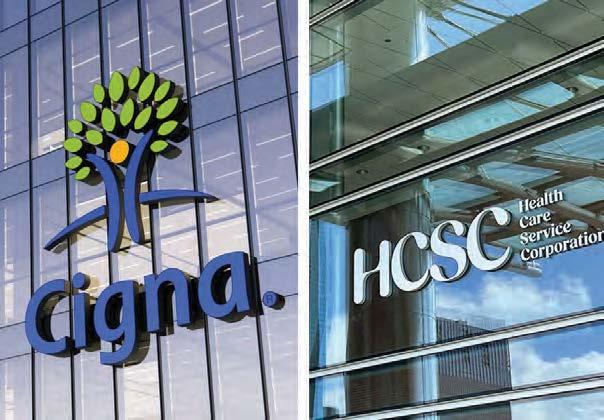
“We certainly could see some consolidation among the smaller ones, whether it's for market advantage or just for survival,” Abrams said. “As things get
tougher, you're likely to see more of that.”
Lauren Berryman writes for Crain's sister publication Modern Healthcare.





2 | CRAIN’S CHICAGO BUSINESS | FEBRUARY 26, 2024 1. Business Savings Advanced Account. Interest rate may change at any time. Fees may reduce earnings. 2. Business Savings Advanced Special. O er valid for accounts opened on or after 9/29/23, & subject to change at any time & without notice. Annual Percentage Yield ('APY') accurate as of 10/18/23, with qualifying activities. Minimum daily balance of $0.01 required to obtain APY. O er available to existing or closed savings account customers of Wintrust Financial Corporation ('WTFC') & its subsidiaries or employees. O er combinable with any WTFC checking o er, but not with a Business Savings deposit bonus o er. 3. Business Savings Advanced Special Qualifications. (i) Open new Business Savings Advanced account; (ii) mention o er during in-branch account opening; & (iii) deposit new money (money not currently held at any WTFC location) into the new Business Savings Advanced account at account opening. Business Savings Advanced1 Special .00% APY4 Open a new Business Savings Advanced account and get a 4.00% Annual Percentage Yield ('APY')2 with qualifying activities.3 Variable rate. No minimum required to open. Daily minimum balance of $1,000 required to avoid a $10 monthly maintenance fee. New money only. Learn more at wintrust.com/BizSavings
Advantage despite headwinds
Katherine Davis
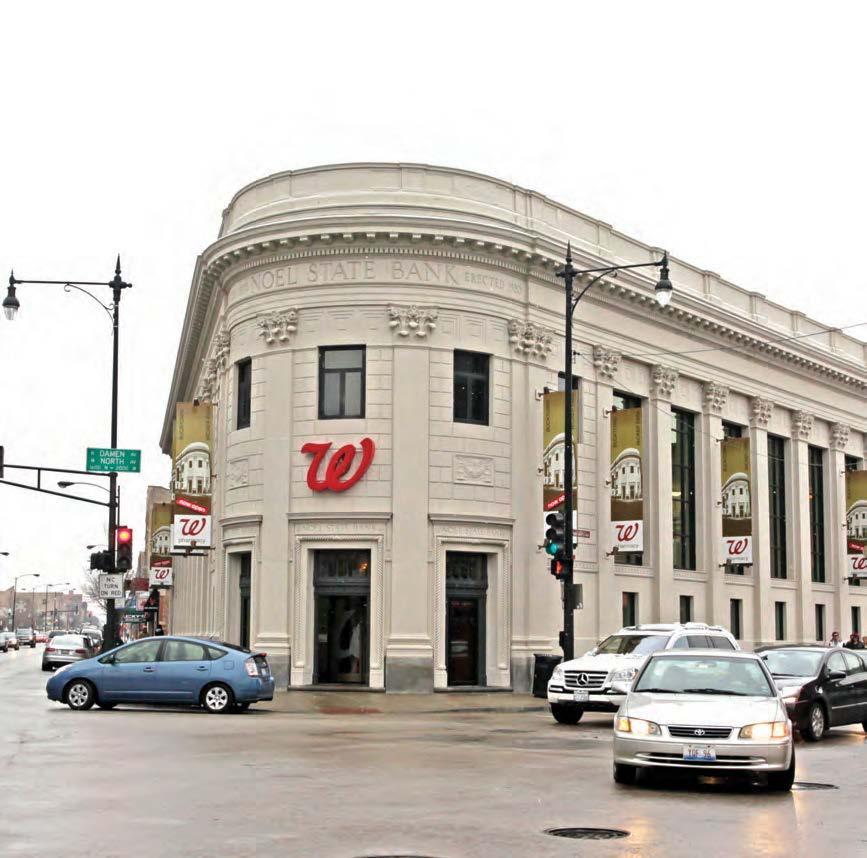
COSTAR GROUP
Barnes & Noble store to open in historic Wicker Park building
The world’s largest retail bookstore chain is also opening three other locations around the metro area
|
By Rachel Herzog
Barnes & Noble will open four new Chicago-area locations this summer, including a store in a recognizable former bank building in Wicker Park.
e world’s largest retail bookstore chain plans to open a store in the former Walgreens agship building at 1601 N. Milwaukee Ave. early this summer, as well as locations at 651 W. Diversey Parkway in Lincoln Park and in suburban Northbrook and Oswego.
“We generally want a bookstore everywhere. Every community, we think, needs a bookstore,” Janine Flanigan, Barnes & Noble's senior director of store planning and design, told Crain's, adding that “we
See BOOKSTORE on Page 26
“We generally want a bookstore everywhere. Every community, we think, needs a bookstore.”
Janine Flanigan, B&N’s senior director of store planning and design
Waukegan hospital loses accreditations, staff and cash
Vista Medical Center East is battling a slew of challenges that reveal, in part,
why the troubled hospital is oundering
Katherine Davis
Vista Medical Center East, the Waukegan hospital that recently lost its Level II trauma center designation and is at risk of losing Medicare accreditation, is battling a slew of nancial and sta ng challenges that reveal, in part, why the troubled hospital is oundering.
e issues have led to sta resignations and a formal complaint led to the state against the medical center, which ultimately led to the stripping of the trauma designation last week, said Michael Sarian, CEO of American Healthcare Systems, a Glendale, Calif.-based hospital operator that purchased Vista Medical last year.
e hospital is losing about $1 million every month as it battles industrywide challenges, like rising expenses for labor and supplies, as well as low or inconsistent reimbursement rates from government and commercial insurance plans, Sarian said.
“Our costs are through the roof,” he said. “Reimbursement is not there.”
Vista Medical also faces worker shortages, particularly among nurses, though Sarian was unable to specify how many open jobs Vista Medical has. “We're doing our best trying to recruit and retain nurses,” Sarian said.
In the meantime, Vista Medical has leaned on travel nursing agencies, but the high costs associated with them are putting even more pressure on the hospital’s margins.
The hospital is losing about $1 million every month as it battles industrywide challenges, like rising expenses for labor and supplies.
Now with scrutiny coming from state and federal regulatory bodies, Vista Medical’s nancial and sta ng challenges are likely to intensify. Without the Level II trauma center designation, the hospital is unable to treat complex — and expensive — conditions. Additionally, if the hospital loses accreditation from the Centers for Medicare & Medicaid Services, or CMS, it will lose the ability to collect reimbursements from patients with Medicare plans. And all that will make it harder to recruit and retain nurses, physicians and other types of employees.
Even still, Sarian said
See HOSPITAL on Page 26
Upstart insurer Kin sees valuation climb over $1 billion
capital market crashed in 2021.
Kin Insurance keeps powering ahead.
e homeowners’ insurance startup raised $15 million in new funding led by San Franciscobased Activate Capital, but it’s the valuation that’s worth noting.
e company, whose valuation topped $1 billion last year, added another 10% in this round, says CEO Sean Harper.
at’s no small feat in what remains an ugly funding environment, especially for later-stage companies, many of which raised money when valuations were soaring before the venture-
Valuations for late-stage investments had dropped 40% by early last year, according to PitchBook. So-called unicorns, or venture-backed companies valued at more than $1 billion, face a culling of the herd. It helps that Kin got to break even last year, when the company added Texas to its list of markets that includes Louisiana, Florida, Arizona, Mississippi, Alabama, South Carolina and Virginia. e business grew about 50% last year, with premiums of about $345 million and Kin’s cut totaling roughly $105 million, Harper says. Kin now has more than 600 em-

ployees, up from 400 a year ago.
Kin launched in 2016, betting on the idea it could operate at a lower cost than traditional insurers by not selling policies through agents, developing its own back-
o ce technology and relying more heavily on technology, such as drones, to manage claims.
“We keep the money they spend on agents and tech,” says Harper, who adds that Kin settled
half the claims from a recent hurricane without visiting a customer's home.
Kin, which is just a fraction of the size of big boys Allstate and State Farm, also bene ted from geography last year. e company serves most coastal markets where hurricanes are a major threat. Last year wasn’t bad for hurricanes, but insurers such as State Farm and Allstate took a pounding because of heavy storm-related losses in the Midwest and parts of the South. State Farm, which also felt the repercussions of res on Maui, reported its worst level of losses on homeowner’s insurance in 15 years, according to S&P Global Intelligence.
FEBRUARY 26, 2024 | CRAIN’S CHICAGO BUSINESS | 3
it raises another $15 million, the Chicago-based home insurer says it’s breaking even
As
1601 N. Milwaukee Ave.
John Pletz
BLOOMBERG
One of the city’s largest hotels is changing hands in a $500 million deal
The owner of the Sheraton Grand Chicago exercised its option requiring Marriott International to buy the Streeterville hotel
Hotel giant Marriott International will purchase the Sheraton Grand Chicago in Streeterville for $300 million and plans to pay an additional $200 million for the land, in accordance with the terms of a settlement agreement with the property’s owner.
A venture controlled by New York-based Tishman Realty that owns the 1,218-room hotel at 301 E. North Water St. has exercised its option to require Marriott to purchase the hotel, which was granted to Tishman as part of a 2017 settlement.
e deal is expected to close in the fourth quarter of 2024, and Marriott has exercised its option to purchase the underlying land for an additional $200 million in cash at that time, Marriott disclosed in a Feb. 13 ling with the U.S. Securities & Exchange Commission. Marriott has factored in $500 million in outgoing cash into its net income for 2024, according to the corporation’s Feb. 13 earnings call.
e settlement stems from a lawsuit that a Tishman venture brought against Starwood Hotels in 2016 over Marriott’s merger with Starwood that year. e lawsuit alleged that 18 Marriott hotel
properties would breach a noncompete clause in Starwood’s management contract for the Streeterville hotel.
e settlement agreement gave Tishman the option to force Marriott to buy the hotel in 2022. In the third quarter of 2021, the agreement was amended to move the period in which Tishman could exercise that option to the rst half of 2024, according to Marriott’s SEC ling.
e amount Marriott is paying for the hotel is less than the property’s previous reported value. e hotel was appraised at $320 million in August 2017, according to Bloomberg data tied to the CMBS loan secured by the property. It was appraised at $380 million in 2013, Crain’s previously reported.
Meanwhile, the value of the land the hotel is on has skyrocketed since Tishman acquired it for about $52.5 million in 2009.
e 2.3-acre parcel was appraised at more than $100 million in 2011, according to loan documents.
It wasn’t immediately clear why Tishman chose to exercise the option to sell the hotel to Marriott, and the investor did not respond to requests for comment. Debt could be a factor: A
$115 million loan secured by the property that a Tishman venture obtained from Wells Fargo in 2017 came due in November, though the borrower had exercised an option to extend the due date, according to Bloomberg loan data. e loan was packaged with other loans and sold o to commercial mortgage-backed securities investors after it was issued.
Exercising the option to sell to Marriott likely provided Tishman with good value and a convenient infusion of cash at a time when re nancing the property would be di cult and expensive due to high interest rates, said Hans Detlefsen, president of Chicago-based consultancy Hotel Appraisers & Advisors.
‘Probably a good deal’
“It’s probably a good deal right now. It’s a way to recycle a lot of capital, and it’s a way to reduce your debt load by a lot and probably some of your more expensive debt if you’re re nancing it in today’s environment,” he said.
Hotel values have been volatile throughout the past decade, and downtown Chicago’s hospitality industry is still recovering from the pandemic. Revenue per available room — a key performance

metric that accounts for both room rates and occupancy — across hotels in the central business district averaged $147.87 during the 12-month period that ended in December, according to real estate information company
CoStar Group. at was up slightly from the average during the same period in 2019, before COVID-19 upended the market, but still below the pre-pandemic level when accounting for in ation.
Old Orchard mall owner taps local developer for 400-unit apartment and lifestyle project
The
24-hour destination, offering living, dining, entertainment and shopping options
e owner of the West eld Old Orchard shopping mall has tapped local developer Focus to build about 400 luxury apartments on the site of a vacant department store, a step forward in one of suburban Chicago’s biggest mall revitalization e orts. Paris-based Unibail-RodamcoWest eld’s endeavor to turn the Skokie retail center into an around-the-clock destination where people can live, dine, and seek out entertainment as well as shop is part of a broader trend among developers looking to reinvigorate suburban malls — and one that Focus has been a part of before. e Chicago developer recently started the second phase of a plan to build more than 600 apartments at Aurora’s Fox Valley Mall, and a 311-unit apartment complex that Focus built at Hawthorn Mall in Vernon Hills opened in June.
e rm’s experience with res-
idential development in suburban downtowns over three decades has given the developer an understanding of “the vision of these malls becoming mini city centers of suburbia,” Focus CEO Tim Anderson said.
Project to begin in 2025
Focus plans to break ground on the apartments at Old Orchard, which will involve demolishing a shuttered Bloomingdale’s store at the northwest corner of the property, in 2025 and open the apartments to residents in early 2027. e developer will go through the village’s planned development approval process this year, Anderson said.
Focus and URW are working on securing outside capital to help nance the project, Anderson said. He said the mall owner has been able to attract investment for its other North American mall redevelopment projects.
“I think the demand for multifamily is there, and the unique-
ness of this asset is so critical,” he said. Mall owners’ e orts to breathe new life into suburban shopping malls by adding housing stock coincides with strong demand for apartments in the Chicago area. Net monthly rent at apartment buildings in suburban Chicago was up 5.4% year over year in the fourth quarter of 2023, according to the Chicago o ce of appraisal and consulting rm Integra Realty Resources.
Geo Mason, executive vice president of U.S. development, design and operating management for URW, said that while some developers with underperforming malls are “densifying” with apartments to turn things around, at Old Orchard that strategy serves to enhance what’s already there. e mall has had more than a dozen tenants open locations or expand space in the last year, including home furnishings company Arhaus, fashion brand Zara and high-tech

“To be extremely successful,
you need to have the absolute best retail, dining and leisure options, and then it becomes a true enhancement to a larger mixeduse community,” Mason said.
4 | CRAIN’S CHICAGO BUSINESS | FEBRUARY 26, 2024
Grand Chicago COSTAR GROUP
Rachel
Herzog Sheraton
development aims to transform the shopping center into a
mini golf experience Puttshack, which are set to open locations in the mall’s former Lord & Taylor store in 2024.
Rachel Herzog
Rendering of Unibail-Rodamco-West eld and developer Focus’ planned apartment project at Old Orchard Mall in Skokie. UNIBAIL-RODAMCO-WESTFIELD


If your business accepted Visa and/or Mastercard between 2004 - 2019, you’re now eligible to claim your share of a $5.5 billion Settlement. Claim your share now.


Merchants (business owners) who accepted Visa and/or Mastercard at any time from January 1, 2004, to January 25, 2019, are eligible to claim their share of a $5.5 billion Settlement. Visa and Mastercard and their issuing banks (the “Defendants”) are alleged to have violated nothing wrong. They claim their business practices are legal.
www.PaymentCardSettlement.com to get more information about the Settlement. The May 31, 2024
STEP ONE:
Scan the QR code to go to www.PaymentCardSettlement.com
STEP TWO: information requested about your business.
STEP THREE:
Submit your claim! Your claim process is now complete.









www.PaymentCardSettlement.com.
you need additional help or information? Email: Visit
Call:
Do
Online:
PAID ADVERTISEMENT
McDonald’s founder Ray Kroc and wife live on in their old Lake Shore Drive co-op
The couple, both deceased, are depicted in a Renaissance-themed mural that wraps the stairs in the high-style residence they bought in 1969, which is now on the market for $1.6 million |
By Dennis Rodkin
When Ray Kroc, who built the McDonald’s empire, and his wife, Joan, moved into a grand Lake Shore Drive co-op in 1969, they had a painter include them in a Renaissance-themed mural on the walls of the spiral staircase.
Half a century and two rounds of ownership later, the faces of Ray and Joan Kroc are still there.
On one wall is Ray Kroc, the Oak Park native who built one of the world’s largest restaurant chains, in the checkered costume of a harlequin. On another, Joan is depicted arriving by boat in a pink and white gown as an attendant shades her with a parasol. Nearby, a heart surrounds the initials J & R, painted to look like they’re carved in stone.
At the base of the stairs is a bar, with a glassware cabinet concealed behind some of the mural.
“It’s fascinating to see them in this operatic scene,” says Jim Kinney, Baird & Warner’s vice president of luxury home sales, who is representing the co-op unit for its sellers, the family of Michael Murphy, a former Sara Lee chief nancial o cer, who died in October.
e unit, on the 25th and part of the 26th oors of a 1920s coop building designed by Robert De Golyer, is for sale with an asking price of $1.6 million.
at’s less than Michael and Adele Murphy paid in 2003. Kinney says they paid more than $2 million, but he does not have a complete gure.
Because it’s a cooperatively owned building rather than a condominium, Cook County records do not say clearly what the Murphys paid.
e unit has formal living and dining rooms facing Lake Michigan, a kitchen on the building’s northeast corner with a view up the lakefront and several rooms with views west and south, into the city. On the 26th oor, most of what was originally a long west-facing terrace has been en-


closed for use as living space, but there’s still outdoor space on the southeast corner.
Reduced asking price
The reduced asking price is in large part because “the place needs redoing,” Kinney says. The work would include the kitchen and baths, redone two decades ago, and replacing antiquated windows, among other things.
Kinney is even sanguine about the possibility that a buyer might paint over the two-story mural that winds around the spiral stair-
case connecting the two levels.
“If a buyer would preserve it, that would be great,” Kinney says, but he and the sellers “know some people will think it’s kitsch.”
Signed only with the name Hoffman and the year 1969, the mural is likely part of a lavish decoration scheme done for the Krocs by the House of Raymond Jacques. A prominent Michigan Avenue design firm in the 1960s, the firm, according to archived Chicago Tribune articles, redecorated the Krocs’ Lake Shore Drive and Fort Lauderdale condos in the first few


years after they were married. The couple also had a ranch near San Diego.
e Krocs bought the Lake Shore Drive condo in 1969, historical articles say, but it’s not clear when they sold it. He died in 1984 and she in 2003. e owners who bought from the Krocs sold to the Murphys in 2003.
Kinney says the operatic theme of the murals resonates because it’s believed that the co-op’s original owner, in the 1920s, was Samuel Insull, the Chicago-based king of a vast American utilities empire and builder of the Civic
Opera House on Wacker Drive. Historical articles show Insull living at the building, 1242 N. Lake Shore Drive, but Crain’s could not con rm it was in this unit.
e Mitchells not only kept the Kroc mural intact but used it as inspiration for decoration in other rooms. On the 26th oor is a mural of a top-hatted man out of 19th-century artist Gustave Caillebotte’s paintings looking out over 20th-century Chicago buildings, and in the breakfast room are springtime murals on the wall and ceiling.
Portillo investment group markets a Florida penthouse at $32.5 million
If sold at the listing price, the 16,803-square-foot residence would be the highest-priced resale condominium unit ever in Naples
Corli Jay
Hot dog mogul Dick Portillo is one of a group of investors that have renovated a high-rise penthouse in Naples, Fla., and put it on the market for $32.5 million — an asking price that, if it holds up, would make it the highest-priced resale unit in Naples ever.
The 16,803-square-foot condo is being marketed by John R. Wood, the Southwest Florida affiliate of Christie's International Real Estate.
e property at 81 Seagate Drive in e Seasons at Naples Cay was restored by a development team that included Portillo, C&E Builders and an executive at Florida-based eory Designs.
No financial details were given on how much Portillo invested in the project.
The penthouse features floorto-ceiling glass windows and 360-degree views of the Gulf of Mexico and the city of Naples. Portillo, who owns a condo in Naples, has been investing in real estate for years, including properties in the Chicago area.
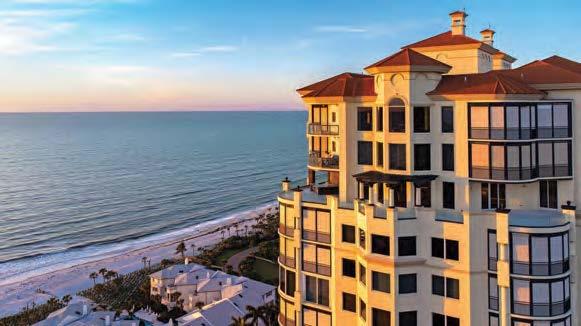
6 | CRAIN’S CHICAGO BUSINESS | FEBRUARY 26, 2024
PHOTOS BY DENNIS RODKIN
INTERNATIONAL REAL ESTATE
CHRISTIE’S
Rivian hires new marketing chief from Meta
Jennifer Prenner has more than 20 years of business experience
Laurence Iliff, Automotive News
Rivian Automotive has named Jennifer Prenner as chief marketing o cer as the EV maker prepares for a major expansion phase with newly hired executives from tech companies and the auto industry, including from Apple and Porsche.
Prenner comes from Facebook's parent company Meta, where she served as vice president of global marketing, with responsibility for its portfolio of virtual reality and augmented reality products, Rivian said.
Prior to her three-year stint at Meta, Prenner was Amazon's global head of marketing, growth and customer engagement for the company's Fire TV business, Rivian said in a post on LinkedIn.
“Rivian's mission is one that I'm proud to contribute to and I look forward to making the world more eco-friendly, and adventurous, one amazing vehicle at a time,” said Prenner, who also holds the title of vice president.
Prenner, with over 20 years of business experience, will lead Rivian's marketing worldwide, including customer loyalty and reaching new audiences, the company said Feb. 12.
Other high-level hires
e EV startup, based in Irvine, Calif., has announced other highlevel hires in recent months as it prepares its next phase of growth.
On March 7, Rivian plans to present its next-generation R2 platform that will underpin more affordable vehicles. e automaker is building a factory near Atlanta for the R2 models.
Rivian makes the R1T pickup and R1S crossover at its plant in downstate Normal, Ill., in addition to electric delivery vans for Amazon. e R1T starts at $71,700 with shipping and the R1S starts $5,000 higher. e R2 vehicles, expected in 2025, are expected to sell for under $50,000, Rivian CEO RJ Scaringe has said.
Rivian's recent hires include DJ Novotney, an Apple Inc. veteran who helped start e orts to develop an electric vehicle at the technology company, Bloomberg reported in late January.
Novotney's title at Rivian is senior vice president of vehicle programs, according to his LinkedIn pro le. His last title at Apple, where he worked for 25 years, was vice president of engineering. His list of accomplishments include working on Apple's rst-generation products, including the iPod, iPhone, iPad and Apple Watch.
In September of last year, Rivian hired Porsche's former North America CEO Kjell Gruner as chief commercial o cer, overseeing sales, marketing and service.
Gruner steered Porsche's U.S. business through the pandemic and put it on track to hit a threeyear sales high last year. During
Startup founded by former FTX exec closes second funding round
Architect Financial Technologies will use the $12 million raised to launch its derivatives brokerage, open a Chicago of ce and double headcount
Mark Weinraub
Architect Financial Technologies said it raised $12 million in capital, its second round of fundraising since its launch in January 2023.
e Chicago-based startup is led by Brett Harrison, who was previously president of FTX US before the crypto giant collapsed. Architect, which develops trading and portfolio management software for assets around the world, said it planned to use the money to support the launch of its U.S. derivatives brokerage for retail and institutional investors.
“It was an opportunistic time to raise funds for us,” Harrison told Crain’s. “It was a combination of our recent progress on the development and production of our trading platform as well as in response to what we see as changing market dynamics.”
Rising demand for retail and in-
his automotive career, Gruner also worked at Mercedes-Benz, according to his LinkedIn pro le.
“We will rely on Kjell's talent and experience as we position ourselves for growth domestically and internationally, the launch of a new platform in R2 at a new facility and the continued success of our commercial vehicle line,” Scaringe said at the time of Gruner's hiring last year.
Rivian also hired auto industry veteran Carlo Materazzo as vice president of logistics, the automaker said in November.
Before joining Rivian, Materazzo worked at Stellantis North America as vice president of manufacturing, Rivian said. He also worked at Stellantis predecessor Fiat Chrysler Automobiles and bring more than two decades of automotive experience.
“Carlo will play a crucial role in the continued improvements in our Illinois factory and as we set up our new facility in Georgia,” said Frank Klein, Rivian's chief operations ocer, in the November release.
Rivian said early this month that the R2 reveal will be March 7, but didn't provide details.
Public documents from the city of Laguna Beach, not far from Rivian's headquarters, said the auto-

maker plans to host a worldwide product reveal on that date at its brand-awareness center in the city and to display some vehicles on city property along the beach.
‘Need for alternatives’
“ ere's an extreme vacuum of choice we feel in the sort of $45,000 to $50,000 price range for midsize SUVs,” Scaringe said in November on Rivian's third-quarter earnings call. “We see very highly concentrated market share with Tesla, but we believe there's a need for alternatives.”
Because of delays in breaking ground on its factory in Georgia,
production of the R2 vehicles isn't scheduled until 2026, a year later than originally forecast by the automaker. Some forecasters say the start of production could slip further.
“With nearly three years to get the plant up and running, that timing is reasonable, but that timing is also likely to slip into 2027,” Sam Fiorani, vice president of global vehicle forecasting at AutoForecast Solutions, told Automotive News earlier this month. “Rivian is anticipating volumes as high as 200,000 per year.”
Laurence Ili writes for Crain's sister publication Automotive News.
stitutional derivatives trading as well as growth in the tokenized asset markets contributed to strong investor interest in Architect. e most recent fundraising round was co-led by BlockTower Capital and Tioga Capital. It brings the company’s total capital raised to $17 million following a $5 million raise in 2023.
Harrison said that although the company was in a “good place for capital,” there could be opportunistic reasons to raise more money, particularly since the most recent round was oversubscribed.
In addition to the launch of the U.S. derivatives platform, Architect will use the money to move its o ces from Evanston to the Lincoln Park neighborhood of Chicago, Harrison said. e company also expects to at least double its headcount in the next year from the current 15 and expand its offerings into the European and Asia-Paci c regions.


FEBRUARY 26, 2024 | CRAIN’S CHICAGO BUSINESS | 7
LUXURY HOME SPOTLIGHT Advertising Section MARY GRANT 312.339.2018 cell NE WLY RE BU ILT IN EA ST KE NI LWOR TH! 611 A BB OT SFOR D ROA D – Offered at $4,850,000 Complete restoration and new construction features of an iconic single-family East Kenilworth home. New floor plan with 7,500 square feet on a .56-acre double lot and new construction 4-car heated garage with coach house with a full kitchen and full bath.
Jennifer Prenner, Rivian’s new chief marketing of cer | RIVIAN
Ford CEO says automaker will rethink where it builds vehicles in the wake of UAW strike
Jim Farley also said the automaker is pivoting its EV strategy to focus on a cheaper platform that can make money sooner
Michael Martinez, Automotive News
Ford Motor Co. CEO Jim Farley on Feb. 15 suggested the automaker could move some production in the wake of an expensive UAW labor contract reached after a contentious strike last fall, though he reiterated that the Dearborn-based company can fully o set those increases through cost e ciencies.
Farley said Ford had been proud of its prior strong relationship with the UAW and was disappointed when the union shut down multiple plants, including its highly pro table Kentucky Truck operation.
“ at was a moment for us,” Farley said. “Clearly our relationship has changed. . . .Does it have a business impact? Yes.”
UAW President Shawn Fain has indicated that the union will take a more confrontational tone with the automakers in the future, saying “the days of the UAW and Ford being a team” to compete against nonunion rivals were over.
Farley said Ford understands that employing more UAW workers and building more vehicles in the U.S. than its competitors has a cost. e new contract could prompt some reevaluation as the business evolves, he said.
He added: “As we look at this EV transition and ICE lasting longer and our truck business being more pro table, we have to think carefully about our footprint.”
Ford previously pledged to invest more than $400 million in
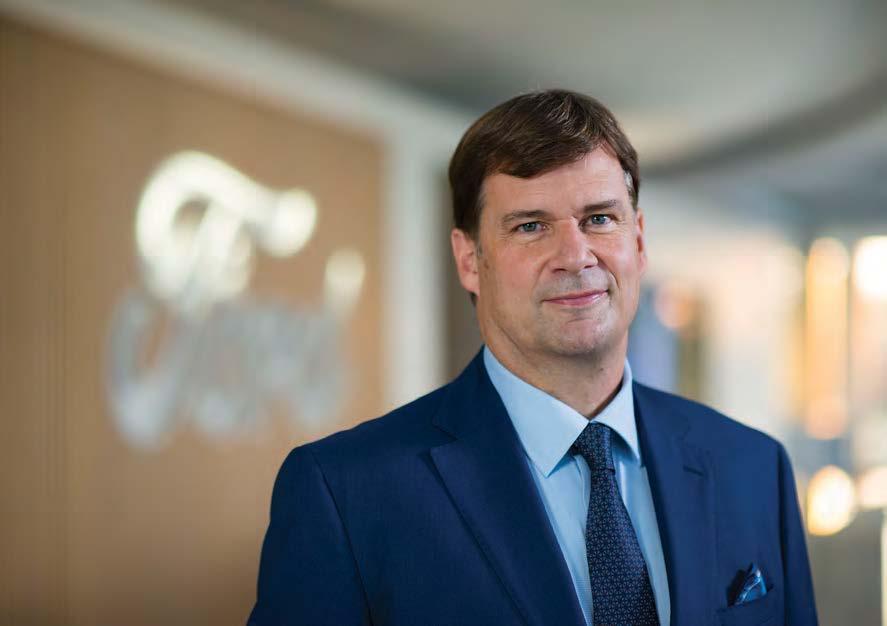
its two Chicago-area factories as part of its new contract with the UAW.
Shift in EV strategy
Farley said the shifting market for electric vehicles has made it tougher to predict the pro tability of those models but that the automaker needs to develop smaller EVs that can make money quickly.
“I’ve been in the prediction business in the EV business; it
hasn’t been a great journey,” Farley said during the Wolfe Research Global Auto Conference in New York. “It feels great in the moment to say, ‘it’s 2027,’ or whenever it is, but it’s not reality anymore.”
Ford in recent months has delayed billions of dollars in investments, cut production, walked back margin targets and essentially recalibrated its EV strategy in the wake of slower-thanexpected growth in consumer
demand. Farley this month said the company is changing tack to develop a smaller, more a ordable EV platform that can be pro table soon after launch. “It’s nonnegotiable that we’re going to allocate capital to a new a ordable electric vehicle . . . and you have to make money in the rst 12 months,” he said Feb. 15, recounting the message he gave his team. “And I don’t want a bullshit road map. I want, like, a real plan. And if you can’t [exe-
cute] that plan, we ain’t launching the car.”
Farley said the company made that decision because the economics on smaller vehicles makes more sense for consumers.
“What the customer has now said to us is, if you have [an EV] larger than Escape, it better be really functional or a work vehicle,” Farley said. “But if you do the economics for a vehicle, let’s say the Escape or smaller, it’s totally different, it completely works. In fact, it’s dramatically better operating cost than a Corolla or Civic or even a Maverick.”
Farley promised that Ford eventually will turn around its money-losing EV business, likening it to overseas operations where the automaker used to lose billions of dollars per year but now turns a collective pro t. e company has said it expects to lose $5 billion to $5.5 billion this year on EVs.
Farley said smaller, cheaper EVs are needed to compete with Chinese automakers, which the head of Ford’s EV unit this month labeled a “colossal strategic threat.” ose companies sell large numbers of EVs in China and are expected to eventually enter the U.S. market.
“If you cannot compete fair and square with the Chinese around the world, then 20 to 30 percent of your revenue is at risk,” Farley said. “We have to x this problem. We have to address this.”
Michael Martinez writes for Crain’s sister site Automotive News.
Veteran Cushman & Wake eld broker sets out on his own
It’s a tough time for retail real estate. To Gregory Kirsch, that makes it a great time to start a new business
Veteran Chicago retail broker Gregory Kirsch is striking out on his own.
After a more than 25-year career at well-established real estate brokerages — most recently leading Cushman & Wakefield’s retail practice for the Midwest — Kirsch has started his own firm, Kirsch Agency, bringing his business partner, Corey Black, with him.
“I’ve been feeling like this is something I’ve been wanting to do for quite some time and finally had the nerve to act on it,” Kirsch said.
It’s a tough time for retail, with vacancy on the Magnificent Mile shopping corridor hovering around 30% since the COVID-19 pandemic decimated foot traffic on North Michigan Avenue. To Kirsch, that makes it a great time to start a
business.
“We’re sitting kind of at the foot of the mountain in terms of recovery,” he said. “It’s a great time to add value. It’s a great time to build.”
Kirsch joins a long line of brokers who have started their own companies after gaining experience at larger firms. While brokerages like Cushman come with resources and clients, boutique firms offer an opportunity to provide good service with low overhead costs — and pocket more commission dollars.
‘I’ll be that guy’
“The trend toward boutiques is really visible, it’s obvious to me,” Kirsch said. “Don’t get me wrong, I hate the idea of following a trend, but okay, yeah, I’ll be that guy.”
Kirsch has represented highprofile clients in the past, in -
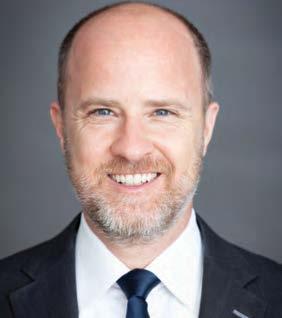
cluding Starbucks and Under Armour, and some clients have expressed interest in retaining him and Black. But “Cushman clients are Cushman clients,” Kirsch said, and he wants to start his new firm from scratch.
“In this business, you can expand kind of quickly if you find people who are willing to en -

gage,” he said. Kirsch pivoted to real estate in the 1990s after a brief career in law, working at Baum Realty Group for 10 years, and then at Newmark’s Chicago office for nearly 11 years before taking the helm of Cushman & Wakefield’s Midwest retail business in 2019. Black has more than
10 years of retail real estate experience, including working for firms Sperry Van Ness and Newmark before joining Cushman in 2019. Both were named to the Crain’s 40 under 40 list: Kirsch in 2009 and Black in 2023.
Independent approach
Kirsch said the decision to start his own firm has more to do with his independent approach to solving problems for his clients than with Cushman. A representative for Cushman & Wakefield declined to comment on the departure.
“This is more like a, ‘It’s not you, it’s me,’ kind of thing,” Kirsch said. “I would rebuild my computer and rip it down and put it back together if I have a problem and want to create a solution. . . .I’m kind of an ‘I want to do it my own way’ type of person.”
8 | CRAIN’S CHICAGO BUSINESS | FEBRUARY 26, 2024
“Clearly our relationship (with the UAW) has changed. … Does it have a business impact? Yes,” Ford Motor CEO Jim Farley said of the aftermath of the weekslong union strike in the fall. | FORD MEDIA
Rachel Herzog
Gregory Kirsch
Corey Black
The new Northbrook center will provide a range of services aimed at urogynecology and gastrointestinal health
Katherine Davis
The University of Chicago Medicine opened a new office in Northbrook focused on providing a range of services aimed at urogynecology and gastrointestinal health.
The 15,000-square-foot office, located on the third floor of a building at 400 Skokie Blvd., opened Feb. 5 after moving from a temporary location in Glenview, according to a statement announcing the opening.
Patients can now book urogynecology and women’s health care appointments at the Northbrook location to address conditions like pelvic floor disorders, endometriosis and uterine fibroids.
Gastrointestinal services, like treatment for Crohn’s disease, ulcerative colitis and motility disorders, will be added this spring, UChicago Medicine said. To treat these conditions, the center will leverage a new intestinal ultrasound.
“We are excited to bring our innovative approach to complex care closer to where our patients live and to where many of our colleagues have asked us to

partner with them,” Dr. David T. Rubin, chief of the section of gastroenterology, hepatology and nutrition and director of the Inflammatory Bowel Disease Center at UChicago Medicine, said in a statement.
The opening of the center,
which holds about 25 employees, marks the latest addition to UChicago Medicine’s growing footprint in the Chicago area, which spans from the northern suburbs to northwest Indiana, where the health system is building a 130,000-square-foot multi -
specialty ambulatory center in Crown Point, Ind., slated to open in May.
Altogether, UChicago Medicine now operates 13 outpatient sites across the region, which complement its hospital and under-construction cancer center,
both of which are in Hyde Park.
Aside from its own medical centers, UChicago has a controlling interest in local AdventHealth facilities after the two organizations entered into a joint venture last year aimed at bringing academic medicine to more parts of the Chicago area. The deal gave UChicago Medicine a controlling interest in AdventHealth’s four Illinois hospitals in Bolingbrook, Glendale Heights, Hinsdale and La Grange, along with nearly 50 physician offices and outpatient locations.
UChicago Medicine is the fifth-largest health system in Chicago, according to Crain’s data. The nonprofit health system reported a nearly $50 million surplus on more than $3.7 billion in operating revenue in the fiscal year ended June 30, 2023, according to its most recent financial report.
UChicago Medicine, however, recently suggested it’s facing industrywide financial challenges when it laid off 180 workers, or more than 1%, of its workforce earlier this month.
“We continue to review further ways to operate more efficiently,” a spokesperson said at the time.
JOIN US
transit system adds over $17.2 billion every year to the region.

FEBRUARY 26, 2024 | CRAIN’S CHICAGO BUSINESS | 9
Chicagoland’s
But to continue driving
change how
TRANSIT IS THE ANSWER TO BETTER BUSINESS Learn more at TransitIsTheAnswer.org/Economy
our economy, we must
transit is funded.
UChicago Medicine expands on the North Shore
UChicago Medicine’s Northbrook medical of ce at 400 Skokie Blvd. UCHICAGO MEDICINE
For a rookie mayor in need of a win, here is a potential playbook
Let's face it: It's been a rough few weeks for Chicago's freshman mayor.
In relatively short order, Brandon Johnson torched his already singed relationship with Gov. J.B. Pritzker by doing an abrupt about-face on migrant funding, while also straining his long-standing bond with political mentor and Cook County President Toni Preckwinkle in the process. Meanwhile, he severed a contract with the maker of the controversial ShotSpotter gunshot detection system, but not before agreeing to extend the deal for an additional nine months — an extension that will cost the city more than it paid for the entire past year of service. And in the midst of all that, he attempted a hard reset of his fractious relationship with the media by agreeing to a sit-down with the Chicago Sun-Times editorial board, only to call the meeting o when he learned the conversation was to be on the record.
And that mess comes just a few weeks after what Crain's columnist Greg Hinz termed Johnson's "terrible, horrible, no good, very bad week" back in December, when a ap erupted over Johnson's plan to house migrants on top of a polluted Brighton Park site, the key leadership of World Business Chicago resigned pretty much in unison, Choose Chicago's chief headed for the exits, and erstwhile ally Ald. Jeanette Taylor openly declared progressives are "not ready" to govern Chicago.
So, to be clear, Johnson is a mayor in desperate need of a win. A big win.
An opportunity for just such a win is emerging in the increasingly contentious debate around new stadiums for both the Chicago Bears and the Chicago White Sox.
As even non-sports fans know by now, the owners of both franchises are unhappy with their current digs and shopping around for better locations as well as 21st century amenities of the kind fans would experience at, say, SoFi Stadium in Inglewood, Calif., Allegiant Stadium in Las Vegas, or Globe Life Field in Arlington, Texas. ey're also shopping for public dollars.
PERSONAL VIEW
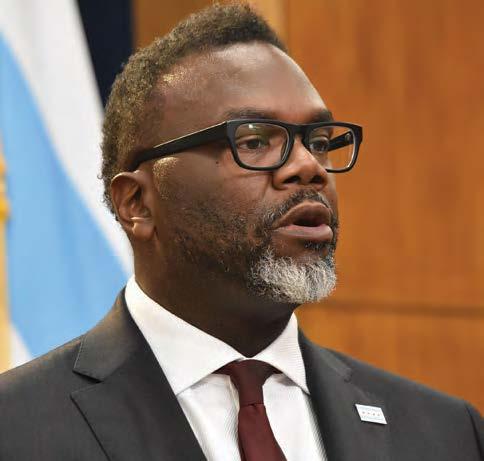
In a town populated by long-su ering fans of these two teams — not to mention people who still feel burned by having to help pay for the construction and renovation of the elds where their abysmal level of play has taken place — the idea of ponying up even more taxpayer dollars for new stadiums should be a political nonstarter.
Viewed another way, however, the Sox and Bears' appetite for new arenas could be an opportunity for Johnson — and, in turn, for the city at large.
at's because one of the biggest challenges Chicago faces — beyond hiring an all-pro quarterback or a better bullpen — is rethinking the very purpose of the city's downtown. Post-pandemic reality is setting in: e business district is unlikely to return to what it was in e Before Times. O ce vacancies are at record levels. e Loop is remarkably quiet on Mondays and Fridays, when
so many Chicago employers allow sta ers to work from home. Restaurants and retailers are reeling from the loss of foot tra c. And o ce building owners and the banks that lend them money are grappling with default, foreclosure and the so-far unanswered question of what happens next.
Against that backdrop comes Sox owner Jerry Reinsdorf, tin cup in hand, followed closely by Bears CEO Kevin Warren, who may not have as clearly de ned a plan just yet but is without a doubt equally as eager to tap into limited Illinois Sports Facilities Authority co ers to realize his apparent dream of building a new stadium in the city rather than Arlington Heights.
is is Johnson's opportunity to seize on their ambitions and press both teams to make a cogent and coordinated case for public nancing — a case predicated as much on the potential public bene t as it would be on the teams' own goals. Johnson could push the Bears and Sox organizations to work together on a combined proposal that would help answer the question of what the central business district could be going forward.
e teams wouldn't necessarily have to share a stadium under this scenario, but if they are going to ask for taxpayer nancing, they should be compelled to present an imaginative, ambitious and comprehensive plan that would not only enhance the value of their own franchises but generate the kind of investment, energy and round-the-clock activity that could jump-start a downtown in urgent need of a jolt.
Unhappy taxpayers and disgruntled sports fans — an overlapping Venn diagram if ever there was one — are unlikely to be thrilled by the prospect of devoting public dollars to this sort of enterprise. But with the right combination of big thinking and purposeful planning, a blueprint could be sketched out that would advance our shared civic interests and not just those of the Reinsdorfs and the McCaskeys. If Johnson uses the leverage that came with the job and makes something like this happen, it could go a long way toward erasing the memory of his until-now inauspicious tenure.
Chicago has a blueprint for xing college a ordability
There's a big debate and divide in Washington right now about student loan relief.
Ten years ago, Chicago cracked the code on college access. is year, 2024, marks the 10th anniversary of America's rst and longestrunning, city-administered free community college program: the Chicago Star Scholarship. It may shed light and provide inspiration on how to resolve a di cult and perplexing challenge: college a ordability.
e scholarship program struck a simple bargain between the city of Chicago and Chicago students. If you graduate from high school earning a B average, your education at City Colleges of Chicago is free. Tuition and textbooks won't cost you a dime.

City Colleges of Chicago classmates, Star Scholars' grade point averages are almost a quarter-point higher. eir retention rate is 27% better than the local average. e graduation rate of Star Scholars is seven points greater than the national average. In the last 10 years, the Chicago Star Scholarship has been copied by Los Angeles, Boston and many other cities; as they say, imitation is the sincerest form of attery.
to require students to develop a personalized postsecondary plan to receive their high school diploma. Upon graduation, you had to have an acceptance letter from a college, community college, vocational school, or armed services branch to receive your high school diploma. We dramatically expanded Dual Credit and Enrollment, Advance Placement, and International Baccalaureate o erings, all college-accredited programs.
e Chicago Star Scholarship premise drives responsibility: Its promise delivers opportunity. e statistics tell the story of this rst-of-its-kind initiative. In just one decade, nearly 18,000 students have earned Star Scholarships and enrolled at City Colleges. ree- fths of them — or almost 11,000 Star Scholars — are the rst in their family ever to attend college. Star Scholars outperform and outpace their peers in classrooms locally and nationally. Compared to fellow
Nearly two-thirds of Star Scholars who earned their associate degree free from City Colleges transferred to a four-year program upon graduation. As of this year, 26 colleges and universities have signed on as Star Scholar Plus partners, helping students complete their bachelor's degrees. e Star Plus program is based on the same bargain. If you maintain your B average during your community college years, you receive significant tuition reduction o your remaining college education from one of the partner universities. e Star program was built on the successful adaptation and reform of our high school education, from solely focused on graduation, to also encompass a collegecareer education model.
Chicago became the rst urban district in the country
By 2019, 50% of the city's students graduated with college credit in their back pocket. Our high school graduation rate jumped from 56% (2010) to 82.5% (2019). Finally, 64% of our high school students enrolled in a college program. is is more impressive and important when you remember that 84% of Chicago students come from households at or below the poverty line.
In this global race for talent, cities can't continue to wait to address college a ordability and accessibility for our nation's youth and their future. Today's students are tomorrow's workforce. Given that nearly 60% of all future jobs will require at least two years of higher education, a high school education alone won't cut it anymore. e Star program modernized our educational requirements and expectations to match the economic requirements
10 | CRAIN’S CHICAGO BUSINESS | FEBRUARY 26, 2024 EDITORIAL
Sound off: Send a column for the Opinion page to editor@chicagobusiness.com. Please include a phone number for veri cation purposes, and limit submissions to 425 words or fewer. Write us: Crain’s welcomes responses from readers. Letters should be as brief as possible and may be edited.Send lettersto Crain’s Chicago Business, 130 E. Randolph St., Suite 3200, Chicago, IL 60601, or email us at letters@chicagobusiness.com. Please include your full name, the city from which you’re writing and a phone number for fact-checking purposes.
ALAMY
Rahm Emanuel is U.S. ambassador to Japan, a former mayor of Chicago, a former White House chief of sta and a former member of Congress.
See AFFORDABILITY on Page 11
Brandon Johnson
A Sox move to e 78 could bene t the entire city
The White Sox's lease in Bridgeport is up in 2029, making this year pivotal, when the team's leadership must make decisions that will a ect the future of Chicago. ere's much debate over where the White Sox should land and over what's best for the team, the city and our neighborhoods.
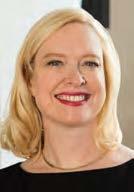
Eleanor Gorski is president and CEO of the Chicago Architecture Center.
e Chicago Architecture Center, a champion of the built environment and a booster for Chicago, is watching this conversation closely. e proposed move of the White Sox from Bridgeport to e 78, a 62acre site along the river at Clark and Roosevelt, could jump-start development in two locations while creating new housing and amenities for Chicagoans.
As a former city of Chicago deputy commissioner of design and planning, I led the ve-year repositioning of Wrigley Field and have a unique perspective on large public/private urban projects and on how ballparks interact with, and in some cases create, their neighborhoods.
Stadiums are now the center of districts, rather than the standalone entities that proliferated across major U.S. cities in the 1970s and '80s. The White Sox's current home was one of the last stadiums completed under the old model, and its design and economics were almost obsolete upon delivery in 1991. A successful urban stadium now favors population density, transportation options and multiuses to generate income year-round. Some stadiums have stayed put while accommodating these needs (see Wrigley Field), and others have rebuilt entirely (such as PNC Park in Pittsburgh).
e 78 has bene ted from multiple planning e orts over the
AFFORDABILITY
From Page 10
and needs of the 21st century.
Every young person with drive and determination deserves a choice and a chance. Nearly 18,000 Star students earned it — nothing less. e Chicago Star program results o er Washington a road map to resolving the combined issues of college a ordability and income inequality. To open the doors of opportunity and transform college a ordability, Chicago developed a better idea and o ered our students a better bargain.
No student's educational outcome should be limited by their parent's income. No parent should have to take a second job or take out a second mortgage to give their child a chance at a better future. In Chicago, they no longer have to.
last eight years, including Amazon HQ2, Discovery Partners Institute and Bally's casino, with much community input resulting in an extensive planned-development framework that includes a new riverwalk and high design standards. With this lion's share of the pre-development work complete, it's possible to begin construction in this area quite soon. A new ballpark at e 78 would likely result in a mixed-use neighborhood and provide well-programmed open space for all to enjoy.
Moving the Sox to e 78 would


create opportunity to re-imagine the old Comiskey site, transforming the stadium and its surroundings into a well-planned area that blends into the Bridgeport neighborhood and creates housing and a tax base. As the site on 35th Street is owned by the Illinois Sports Facilities Authority with no prior planning or framework in place, the Chicago Architecture Center recommends a thorough community design process led by urban planning professionals who can balance local needs with best practices for a new neighborhood



that knits into the Bridgeport community. Whomever tackles these two projects must ensure that all of Chicago bene ts. e developer for e 78, Related Midwest, has a history in Chicago and a record of inclusion and diversity in its projects. It's a founding member of Hire360, whose mission is to strengthen the participation of underrepresented populations by prioritizing socially responsible hiring and vendor selection. Related's work at Roosevelt Square and e Row in Fulton Market proves


that large projects can help small businesses and provide on-thejob training for trade workers to launch their careers. (Full disclosure: Related Midwest Executive Vice President Ann ompson is a member of the Chicago Architecture Center board.)
e big picture: Redeveloping these large properties with sports stadiums provides an opportunity — and an obligation — to thoughtfully plan with community and professional input for the bene t of all Chicagoans and for our great baseball legacy.














FEBRUARY 26, 2024 | CRAIN’S CHICAGO BUSINESS | 11 PERSONAL VIEW
ARCHITECTURE / DESIGN
Gensler, Chicago
ARCHITECTURE / DESIGN
Gensler, Chicago
BUSINESS SERVICES
Circana, Chicago
FINANCE
J.P. Morgan Private Bank, Chicago
NON-PROFIT
CAN TV, Chicago

Rick Fawell, AIA, NCARB has been promoted to Principal at Gensler Chicago. With more than 40 years of experience designing, planning, and managing complex projects, Rick leverages his deep expertise and experience in his role as a trusted partner to leaders throughout the hospitality industry. He thoughtfully guides clients throughout the design process, from early-stage nancing to delivery phases. Rick’s design work has been recognized by numerous awards from organizations including AIA and ULI.

ARCHITECTURE / DESIGN
Gensler, Chicago
Randy Guillot, FAIA, LEED AP has been named Global Healthcare Leader at Gensler. With experience across the healthcare, sciences, education, and workplace sectors, Randy’s leadership in design leverages his belief in multidisciplinary partnerships and creating new models for healing, learning, and working. As a Fellow of the American Institute of Architects and a member of the ULI National Healthcare & Life Sciences Council, his projects have been recognized with more than 50 design awards globally.


ARCHITECTURE / DESIGN
Gensler, Chicago
Stephen Katz, AIA, LEED AP BD+C has been promoted to Principal at Gensler Chicago. As a recognized thought leader, he has authored features on façade design, intelligent building technology, and sustainability for numerous publications and journals. He recognizes an inclusive design process that prioritizes collaboration, listening, and the power of imagination. During his time at Gensler, he has been a Lieutenant in the US Naval Reserves serving as an of cer in the Civil Engineer Corps.


ARCHITECTURE / DESIGN
Gensler, Chicago
Lori Mukoyama, NCIDQ, IIDA, LEED GA has been named Global Hospitality Leader at Gensler. With 25 years in the industry, Lori’s dynamic approach to design champions the creation of brand-forward, experiencedriven environments. She frequently contributes inspiring thought leadership while building her awardwinning portfolio of impactful project work. Lori has a passion for mentoring the next generation of designers and is actively involved in industry organizations IIDA, DIFFA, and NOMA.



A. Sean O’Gorman Jr., LEED AP has been named Global Residential Practice Leader at Gensler. He also leads the residential practice area for the rm’s North Central region, guiding the design and delivery of large-scale multifamily, mixed-use, and adaptive reuse projects with a specialty in sustainability and energy performance. Sean is a licensed architect, LEED accredited professional, and a member of the Chicago Committee on High Rise Buildings.

ARCHITECTURE / DESIGN
Gensler, Chicago
Kristin Oleson, CPA, CGMA has been promoted to Principal at Gensler Chicago. As the Regional Operating Of cer of Gensler’s North Central Region and a licensed CPA, Kristin concentrates on nancial strategy and growth with a commitment to operational excellence. Her role utilizes her breadth of corporate nancial expertise, particularly with operational, nancial, and risk management. She is a member of the American Institute of Certi ed Public Accountants and the Illinois CPA Society.


ARCHITECTURE / DESIGN
Perkins&Will, Chicago
Global architecture and design rm

Eckmann

Fevurly
Perkins&Will announces the promotion of Aimee Eckmann, FAIA, ALEP, LEED AP to rmwide practice leader for K-12 Education and Yvette Fevurly, Managing Principal as the Branded Environments practice leader for the Chicago studio. Eckmann, who started her career at Perkins&Will in 1999, works closely with key school stakeholders –administrators, teachers, parents, students, and community members- bringing her expertise in educational planning and design. Fevurly’s 20+ years of experience in environmental graphics programs, signage, and way nding across the corporate, hospitality, healthcare, and legal sectors brings design direction and mentorship to the agship studio.
BANKING
First Bank Chicago, Northbrook

First Bank Chicago, one of the ve largest privately held banks in Chicago, proudly announces the promotion of Jacqueline Flick to SVP/Community Banking Operations Manager. Jackie is responsible for overseeing day-to-day operations to ensure each branch is operating ef ciently while adhering to bank policies and procedures. She is also responsible for developing procedures and conducting staff training on the implementation of new products and services. She joined our team in 2018.

Circana, a leading advisor on the complexity of consumer behavior, appoints Jeremy Allen as Chief Commercial Of cer. He previously served as President, Consumer Packaged Goods at Circana. In this newly created role, he’ll lead global commercial strategy, leveraging extensive client service experience to promote Circana’s technology, solutions, and insights to help clients worldwide nd new opportunities and spark growth.
BUSINESS SERVICES
Circana, Chicago

Circana, a leading advisor on the complexity of consumer behavior, appoints Wei Lin Wong as president, Consumer Packaged Goods. In this role, he’s responsible for leading CPG commercial teams across the globe, including client engagement, delivery of innovative solutions, and thought leadership. Prior to this role, he served as Circana’s President of Retail and Chief Strategy Of cer.

CONSTRUCTION
Krusinski Construction Company, Oak Brook

Jeffrey Jerry
Krusinski Construction Company, a leader in providing comprehensive construction services, is pleased to announce that Jeffrey Krusinski has been named CEO, in addition to his role as President, effective January 2024. The move follows the planned transition of former CEO Jerry Krusinski to Executive Chairman and the retirement of company founder Joe Krusinski, Sr., who continues to serve as Chairman Emeritus. Jeff and Jerry joined the company in 1994 and 1984, respectively, holding various roles throughout the organization. They focus on the rm’s strategic operations and provide executive oversight on client projects and relationships, leading the organization into its next chapter.


ENGINEERING / CONSTRUCTION
Ardmore Roderick, Chicago
Ardmore Roderick, a major infrastructure solutions rm, welcomes Larry LeMaster, CPA, as Chief Financial Of cer. Larry’s extensive leadership experience positions him as a key player in the company’s nationwide growth strategy. His deep nancial acumen will be crucial in driving Ardmore Roderick’s expansion initiatives.


Jonathan Schwartz has joined J.P. Morgan Private Bank in Chicago as an Executive Director and Banker. Jonathan works with a range of sophisticated clients, including highly successful entrepreneurs, multi-generational families, C-level executives, nancial and legal professionals, family of ces, endowments, and foundations. He delivers seasoned guidance backed by the fortress balance sheet and intellectual repower of a global leader. Jonathan joins the rm from Bluebird Pearson.
FINANCE

J.P. Morgan Private Bank, Chicago
Will Hancock has joined J.P. Morgan Private Bank in Chicago as a Vice President and Banker. Will partners closely with C-suite executives, successful business owners and stewards of family wealth who are looking for a holistic way to manage all aspects of their nancial pictures. He taps the rm’s specialists, thought leadership, and innovative opportunities that align with his client’s interests. Most recently, Will joins the rm from Charles Schwab.
FINANCIAL SERVICES

Buoyant Ventures, Chicago
Buoyant Ventures is proud to announce that Laura Dyer has been promoted to Principal Investor. Buoyant invests in early stage climatetech companies in North America, and is headquartered in Chicago. As Principal, Laura will lead the sourcing, diligence and management of investments, and will lead investment research. Laura has a CPA and previously worked at Ares Management and Deloitte as and an Auditor. She has dual masters in business and sustainability from the University of Michigan.


LEGAL
Adelman & Gettleman, Ltd., Chicago

Adelman & Gettleman, Ltd. is pleased to announce the elevation of Nicholas Dwayne to partner. He joined the rm as an associate in 2017 and his practice involves a full suite of transactional, litigation, and problem solving on behalf of clients facing insolvency issues. Mr. Dwayne is supported by a full team of experienced partners, associates, and staff. A&G is among the oldest boutique commercial insolvency rms in Chicago, handling all aspects of debtor-creditor relations for over 40 yrs.

CAN TV has appointed a new member, Daniel O. Ash, to its board of directors. Ash is the President of the Field Foundation of Illinois, which along with strategic funding partners distributes more than $6.5 million annually in grants to organizations working to address systemic issues in Chicago’s divested communities. Through his career, Ash has focused on developing and using marketing and communication tools to advance social causes.
NON-PROFIT
CAN TV, Chicago

CAN TV has appointed a new member, Nikki Lang, to its board of directors. Lang is the head of the Diversity, Equity and Belonging at Bimbo Bakeries USA, where she leads the company’s strategic goal to build an environment and workplace with BBU’s leaders and associates that advance programs, enact policies and promote mindsets and behaviors that appreciate and value diversity, equity and belonging.
NON-PROFIT
CAN TV, Chicago

CAN TV has appointed a new member, John Robak, to its board of directors. Robak is the former Chairman of the Board and Chief Executive Of cer of Greeley and Hansen, a leading international civil, environmental, and water infrastructure consulting engineering rm headquartered in Chicago. With over 30 years of professional business experience, Robak directs all business affairs of this 20-of ce global rm.

NON-PROFIT
The Morton Arboretum, Lisle
Karen Magid, Ph.D., joined The Morton Arboretum in the newly established position of Chief of Staff. She manages government relations, the institution’s civic presence and pro le, Board of Trustees engagement and institutional planning and project management. Magid holds a Doctorate in Materials Science from UC Berkeley and brings scienti c, sustainability and environmental justice experience to the role, providing key leadership capacity to advance the Arboretum’s new strategic plan.

PEOPLE ON THE MOVE Advertising Section To place your listing, visit www.chicagobusiness.com/peoplemoves or, for more information, contact Debora Stein at 917.226.5470 / dstein@crain.com
To order frames or plaques of profiles contact Lauren Melesio at lmelesio@crain.com
LARGEST EMPLOYERS CRAIN’S LIST
Ranked by full-time local employment as of 12/31/2023. e = Crain's estimate (in gray).
ResearchbySophieRodgers(sophie.rodgers@crain.com)|Localemployment guresincludefull-timeemployeesinCook,DuPage,Kane,Lake(Ill.),Lake(Ind.),McHenryandWillcountiesunlessotherwise noted.Crain’sestimatesareshowningray. e. Crain'sestimate. 1. U.S.government'sestimate. 2. FormerlyAdvocateAuroraHealth. 3. InDecember2022,AdvocateAuroraHealthmergedwithAtrium HealthtocreateAdvocateHealth. 4. Includesestimateddistributioncenteremployment guresfromMWPVLInternationalandWholeFoodsemployees. 5. Includespart-timeemployeesandWholeFoods employees. 6. IncludesemployeesofUniversityofChicagoMedicine,theuniversity'smedicalgroup. 7. FormerlyNorthShore–Edward-ElmhurstHealth. 8. Companyestimate. 9. CalculatedfromSEC lings. Re ects all Albertsons employees. 10. Robert Michael will succeed Richard Gonzalez as CEO on July 1. 11. Includes part-time employees. Get 70 employers and hundreds of executives in Excel format. Become a Data Member: ChicagoBusiness.com/data-lists
FEBRUARY 26, 2024 | CRAIN’S CHICAGO BUSINESS | 13 2023 rankEmployer Head of Chicago of ce Full-time local employees 12/31/2023; 1-year change Full-time worldwide employees 12/31/2023; 1-year change FY 2023 worldwide revenue (millions); 1-year change 1 1 U.S. GOVERNMENT 230 S. Dearborn St., Chicago60604; Chicago.FEB.gov AdeleRapport Chair, Chicago Federal Executive Board 52,315 1 0.0% 2,848,783 2.5% 2 2 CHICAGO PUBLIC SCHOOLS 42 W. Madison St., Chicago60602; CPS.edu PedroMartinez CEO 43,286 4.4% 43,286 4.4% $9,370.0 20.1% 3 5 ADVOCATE HEALTH 2 2025 Windsor Drive, Oak Brook60523; AdvocateHealth.org JimSkogsbergh EugeneA.Woods CEOs 38,679 43.4% 155,000 3 182.1% 4 3 CITY OF CHICAGO 121 N. LaSalle St., Chicago60602; CityofChicago.org BrandonJohnson Mayor 30,918 2.3% 30,919 2.3% 5 4 AMAZON.COMINC. 227 W. Monroe St., Chicago60606; Amazon.com AndyJassy CEO 30,100 e4 3.8% e 1,525,000 5 -1.0% 6 6 NORTHWESTERN MEMORIAL HEALTHCARE 251 E. Huron St., Chicago60611; NM.org HowardB.Chrisman President, CEO 25,386 5.2% 26,194 2.7% $8,721.9 9.2% 7 7 UNIVERSITY OF CHICAGO 5801 S. Ellis Ave., Chicago60637; UChicago.edu PaulAlivisatos President 22,395 6 3.6% 23,038 5.5% $6,942.6 15.2% 8 8 ENDEAVOR HEALTH 7 1301 Central St., Evanston60201; EndeavorHealth.org J.P.Gallagher President, CEO 20,251 3.6% 20,324 3.4% $5,603.0 8 5.8% 9 9 COOK COUNTY 118 N. Clark St., Chicago60602; CookCountyIL.gov ToniR.Preckwinkle President, board of commissioners 19,797 2.8% 19,797 2.8% $8,332.4 -5.6% 10 10 WALMARTINC. 8430 W. Bryn Mawr Ave., Chicago60631; Walmart.com CedricClark COO 17,400 -2.8% 2,100,000 0.0% $611,289.0 6.7% 11 12 UNITED AIRLINES HOLDINGSINC. 233 S. Wacker Drive, Chicago60606; United.com ScottKirby CEO 16,937 8.8% 103,300 17.1% $53,717.0 19.5% 12 11 WALGREENS BOOTS ALLIANCEINC. 108 Wilmot Road, Deer eld60015; WalgreensBootsAlliance.com TimWentworth CEO StefanoPessina Executive chairman 16,486 -4.9% 331,872 2.1% $139,081.0 4.8% 13 13 JPMORGAN CHASE &CO. 10 S. Dearborn St., Chicago60603; JPMorganChase.com AnthonyF.Maggiore President, Midwest middle market banking 15,382 7.6% 293,723 0.0% $158,104.0 22.9% 14 16 HEALTH CARE SERVICECORP. 300 E. Randolph St., Chicago60601; HCSC.com MauriceSmith President, CEO 14,771 13.6% 28,521 11.8% 15 14 RUSH UNIVERSITY SYSTEM FOR HEALTH 1725 W. Harrison St., Chicago60546; Rush.edu OmarB.Lateef President, CEO 14,360 6.6% 14,360 6.6% 16 15 STATE OF ILLINOIS 555 W. Monroe St., Chicago60661; Illinois.gov J.B.Pritzker Governor 14,067 5.6% 46,233 4.7% 17 18 NORTHWESTERN UNIVERSITY 633 Clark St., Evanston60208; Northwestern.edu MichaelH.Schill President 11,777 5.2% 11,952 5.2% $3,046.7 5.6% 18 17 JEWEL-OSCO 150 Pierce Road, Itasca60143; JewelOsco.com MikeK.Withers President 11,589 1.3% 107,300 9 0.0% 19 20 UNIVERSITY OF ILLINOIS CHICAGO 1200 W. Harrison St., Chicago60607; UIC.edu MarieLynnMiranda Chancellor 10,778 4.5% 12,175 5.0% $3,865.0 6.7% 20 19 ASCENSION ILLINOIS 200 S. Wacker Drive, Chicago60606; Ascension.org PollyDavenport Market CEO 10,415 -0.9% 10,415 -0.9% $3,418.4 1.4% 21 21 AMERICAN AIRLINES GROUPINC. O'Hare International Airport, Chicago60666; AA.com BenHumphrey VP, ORD Operations 10,000 0.0% 130,000 0.0% $52,788.0 7.8% 22 22 CHICAGO TRANSIT AUTHORITY 567 W. Lake St., Chicago60661; TransitChicago.com DorvalR.CarterJr. President 9,808 6.3% 9,808 6.3% $1,471.6 5.0% 23 23 ABBVIEINC. 1 N. Waukegan Road, North Chicago60064; AbbVie.com RichardA.Gonzalez Chairman, CEO 10 9,000 0.0% 50,000 11 0.0% $54,318.0 -6.4% 24 25 EMPLOYCO USAINC. 350 E. Ogden Ave., Westmont60559; Employco.com RobW.Wilson CEO 8,405 1.6% 15,087 2.6% $548.9 7.0% 25 38 ANN & ROBERT H. LURIE CHILDREN'S HOSPITAL OF CHICAGO 225 E. Chicago Ave., Chicago60611; LurieChildrens.org ThomasP.Shanley President, CEO 7,880 31.1% 7,880 31.1%







Celebrate Crain’s Women of Note Wednesday, March 6 | 11:30AM-1:30PM Hyatt Regency Chicago, Crystal Ballroom Network and hear inspiring stories from women who are making a difference in Chicago’s business and nonprofit worlds. SCAN THE QR CODE OR VISI T ChicagoBusiness.com/WON24 RE GI ST ER TO DAY PR ES E NTING SPONSOR: CORPORATE SPONSOR: NONPROFIT SPONSOR : MEDIA SPONSOR :


An affordable big city with deep pools of talent, Chicago needs to regain its edge as a place to do business | By John Pletz
In his victory speech after being elected mayor of Houston in December, John Whitmire couldn’t resist taking a shot at Chicago: “We’re not New York. We’re not L.A. We’re sure not Chicago. We x our problems,” he said. “Great cities solve their problems.”
Chicago has taken more than its share of lumps, starting before the COVID-19 pandemic, when it was Donald Trump’s favorite punching bag for urban decline.
en Ken Gri n piled on, moving Citadel’s headquarters out of town, following Boeing and Caterpillar. "Saturday Night Live" writers weighed in recently with
their own burn, noting “Chicago became the largest U.S. city to call for a cease- re in Gaza. And, in return, Gaza called for a cease- re in Chicago.” Is Chicago getting a bad rap, and are we making ourselves too easy a target by not putting our best foot forward to change the narrative? e nation’s third-largest city is still a city that works, but it also has a growing list of very real challenges, topped by crime, that must be addressed.
“We are ghting perception, and you have to be aggressive, or it takes on a life of
See CHICAGO on Page 16

FEBRUARY 26, 2024 | CRAIN’S CHICAGO BUSINESS | 15 CRAIN’S REBRANDING CHICAGO SPONSORS
MICHAEL
WARAKSA
A long road back 2019 2020 2021 2022 2023 The Chicago metro area has had the slowest post-pandemic job growth among seven peers: New York, Los Angeles, Dallas-Fort Worth, Houston, San Francisco, Boston and Miami. Chicago-area employment Source: Bureau of Labor Statistics 4.77 million 4.39 million 4.63 million 4.75 million 4.79 million
No place like here
CHICAGO
From Page 15
its own,” says Andrea Zopp, who was CEO of World Business Chicago, the city’s public-private partnership for corporate recruiting, from 2017 to 2020.
With the Democratic National Convention coming to town this summer, Chicago has a rare opportunity to regain its swagger and reposition itself as a global city at the top of its game, a city second to none as a place to live and work.
Chicago did it before, nearly 20 years ago, by giving itself a makeover for the 1996 Democratic National Convention that continued with the creation of Millennium Park. But this time, the city is approaching its moment in the spotlight without a CEO at the helm of World Business Chicago or its convention and tourism promoter, Choose Chicago.
Chicago can counter the narrative that its best days are behind it by focusing on the strategic advantages that it’s always had as an a ordable big city that attracts a deep pool of educated talent.
“ e Chicago brand remains strong for fundamental reasons,” says Mike Grella, founder of site-selection consultant Grella Partnership Strategies in Atlanta. “It’s the third-largest metro area and a top 20 global economy. It has tremendous talent and some top colleges and universities.
ose fundamentals aren’t going to change.”
Zaid Ashai, CEO of Bostonbased solar company Nexamp, recently chose Chicago for its second headquarters. “It’s extremely livable. Housing is more a ordable than on the coasts: e rents here are 40% to 50% cheaper than rents in Boston. And it’s got a much bigger labor pool. Chicago should sell it more.”
When compared with seven peer cities, the median singlefamily home price in Chicago is the second lowest at $344,479, behind only Houston at $336,308, according to Red n data. Despite a recent pickup, the increase in Chicago home prices since the COVID-19 pandemic also is the second lowest at 31%, trailing a 5% rise in San Francisco, where the median home price is about $1.4 million in 2023.
Chicago has long been a magnet for graduates of the Big Ten schools and other universities. Nearly 41% of residents in the Chicago metro area have at least a bachelor’s degree, according to census data compiled by real estate rm CBRE. It trails only New York (43.6%), Boston (51.1%) and San Francisco (52.4%) among a group of peer cities.
Chicago is second only to New York in the number of Fortune 500 companies, with 25, although Dallas and Houston are closing the gap. But Chicago doesn’t dominate any particular industry in the way that New York does in nance, Los Angeles does in entertainment and San Francisco does in tech.
And Chicago’s economy has

struggled more than most to rebound from the pandemic. Its job growth of 0.3% since 2019 is the lowest among peer cities examined by Crain's.
“Everyone is in a struggle for relevance,” says Steve Koch, who was Chicago’s deputy mayor from 2012 to 2017, heading economic development for former Mayor Rahm Emanuel. “ e world doesn’t need us. We need the world. It will pass us by if we don’t force ourselves on the world and force ourselves into the conversation.”
Blessing and curse
But it’s a conversation that has been changed by the pandemic. Like other big cities, much of Chicago’s appeal and its economic muscle traditionally has stemmed from thousands of workers who used roads and rail lines to come downtown every day, lling o ce buildings and spilling over into restaurants, shops and museums, anchoring the region’s tax base.
“Downtown is not going to survive as just an o ce district,” says Richard Florida, a University of Toronto professor and urbanplanning expert, who famously espoused the theory of “the creative class” and the importance to cities
of attracting young, educated and creative workers.
e shift is a particular challenge for Chicago. Workers who don’t live downtown accounted for 38% of pre-pandemic activity in downtown Chicago, the highest among the 26 largest cities studied by Philadelphia’s Center City District using cellphone data. At the end of last year, it was 31%, ranking second highest, says Paul Levy, chairman of the nonpro t group.
Chicago continues to add downtown dwellers, but o ce buildings are nearly one-fourth empty and transit ridership is about 40% lower than it was before the pandemic.
“How do we gure out as a city what to do with downtown? I’m not sure anyone has an answer to that,” says Glen Tullman, CEO of digital health care startup Transcarent.
Tullman built three companies and an investment rm in the city over the past 30 years. Transcarent’s largest o ces are in Chicago and San Francisco. “When we say, ‘let’s have an event’ and ask people where we want to go, two places we get pushback on are Chicago and San Francisco.”
eighth in the number of international visitors among U.S. cities, according to the International Trade Administration, a U.S. government agency. Chicago was the top U.S. destination for North American corporate travelers last year, according to FCM, the business-travel division of Flight Centre Travel Group.
But overall, visitors are still below pre-pandemic gures.
“ ere are fewer tourists coming to Chicago right now,” says Nick Kokonas, co-owner of several of the city’s best-known restaurants, including Alinea, adding that its out-of-town bookings were down about 7.5% in January from last year. Local tra c is taking a hit, too, in part because of crime. “People who live in the suburbs don’t want to go to the city right now. What they see on TV and Twitter are these incidents … that feel like we’re moving in the wrong direction.”
Homicides dropped 13% last year to 617 and are down from a recent peak of 804 in 2021. But the number of murders in Chicago is dramatically higher than other big cities such as New York (386), Los Angeles (323) and Houston (338).
Robberies in Chicago rose 23% and car theft jumped 37% last year.
Brazen retail thefts have become a black eye for the Magnicent Mile and the Gold Coast. And a lunch-hour shooting on a Friday afternoon in January that killed two high school students didn’t help the Loop’s image. In addition to improving safety, Kokonas says the city needs to focus on reigniting its tourism e orts. “Choose Chicago used to call me on a weekly basis. at outreach is just gone right now.” Don Welsh, who ran Choose Chicago from 2011 to 2016, says the group is chronically underfunded compared with other large U.S. cities and needs more resources.
He says San Francisco is in far worse shape than Chicago. “ e homeless problem is totally out of control. ere are whole streets you can no longer navigate. e shoplifting problem is worse.”
He’s not giving Chicago a pass, however. “You’ve got to x what you can x. You can x safety and make sure people are not camping out on streets,” he says.
Grella, who once led economic development for Amazon, also says the crime problem “is not unique to Chicago, but it’s enough of an issue in Chicago. If you pretend crime doesn’t exist, you’re going to die a slow death. ere are two pieces: One is to x the problem, and the other is to make sure the message stays positive. It’s a real balancing act.”
Tourism’s new role
With o ces still in ux, Chicago's $17 billion tourism business, according to Choose Chicago, becomes more crucial to its overall economy. “Places that have rebounded are the places that have attracted the most local and national visitors,” says Florida. Chicago traditionally has been one of the nation’s top tourist and convention destinations, ranking
Choose Chicago, which is searching for a new CEO, said in a statement: “In the post-COVID world, tourism is more important than ever as an economic driver and an opportunity to challenge misconceptions about our city. We are committed to working in close partnership with the entire hospitality industry to collectively tell the true story of Chicago and drive visitors to our incredible city. With the DNC and other major events on the horizon this year, we have the opportunity to position Chicago as a global ‘bucket list’ destination.”
Whether to increase tourism spending is something the city will have to balance against other policy goals, such as battling homelessness and improving public safety.
e pandemic has added a new wrinkle to that equation as well, with the Bears and White Sox both considering whether to keep their stadiums within city limits. Spending money to help privately owned sports teams won’t be an easy sell when the city and state are staring at major funding shortfalls in pensions, mass transit and education.
“It would be a serious mistake to move major entertainment ven-
16 | CRAIN’S CHICAGO BUSINESS | FEBRUARY 26, 2024 CRAIN’S REBRANDING CHICAGO
Glen Tullman, CEO of digital health care startup Transcarent. | ALYCE HENSON
See CHICAGO on Page 20















From where you are Loans subject to credit approval. The CIBC logo is a registered trademark of CIBC, used under license. ©2024 CIBC Bank USA. Banking products and services o ered by CIBC Bank USA. This ad is not to be construed as an o er to buy or sell any financial instruments. Ambition drives you. Let our expert advice and tailored financial solutions get you from where you are, to where you want to be. COMMERCIAL BANKING | CAPITAL MARKETS | PRIVATE WEALTH cibc.com/US To where you want to be
Vistria Group places its bets on Chicago, a hub for cutting-edge ideas
Like many Chicagoans, we bonded over the Bulls. We agreed that the best Bulls moment was Game 5 of the 1989 Eastern Conference Quarterfinals. It wasn’t just the Cleveland Cavaliers that Michael Jordan was looking to prove something to that night, but a crew of Chicago sports writers who didn’t believe the Bulls could win. In a historic game, Jordan went on to prove the naysayers wrong.
The city of Chicago has many critics, but like Jordan, we know Chicago is a winner. When we founded The Vistria Group a little over a decade ago, we had a shared vision about the opportunity to build a new kind of investment firm with a culture and commitment to delivering both financial returns and societal impact. We thought Chicago would serve as a good home for our firm and never considered locating our headquarters anywhere else.
Why? Chicago is birthplace to many of the world’s noteworthy innovations — from vacuum cleaners to mobile phones and from modern high-rise architecture to, of course, house music. So, what would be a better place

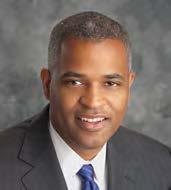
CKip Kirkpatrick and Martin Nesbitt are senior partners and co-CEOs of e Vistria Group. Vistria is a sponsor of Crain’s Forum.
to pursue our own quest to define the future of capitalism than a city with a history of being at the forefront of innovation?
Without question, what makes Chicago a hub for cutting-edge ideas is its people. As business leaders, we value the deeprooted values of hard work and humility that undergird Chicago, and we know they serve as an essential foundation for building valuable and sustainable businesses. Time and again, we have seen that it’s the human element that ultimately determines failure or success.
Chicago has always been a hub for ambitious college grads, drawing from top-tier academic institutions not only in Chicago but from across the Midwest.
Our city continues to attract talented young professionals because of career opportunities, relative affordability, and a thriving cultural scene. To be clear, every big city has its challenges, but very few have Chicago’s strengths. Attracting a diverse group among these emerging leaders has been critical to our journey.
Tight-knit community
Chicago is also a tight-knit community. When we signed our rst lease, we were literally not only betting on ourselves but also that the Chicago business and civic community would support our efforts to invest, create jobs and foster deeper engagement. Our wager paid o . Since then, our rm has expanded in every way that matters. With the view of Millennium Park, Lake Michigan and our dazzling skyline as our backdrop, we’ve expanded our e orts to help our community not just through our investments, but also in the time and resources our team devotes to volunteering and engaging in community.
To be clear, we don’t agree on everything. We have a running dispute on Pequod’s vs. Bartoli’s;
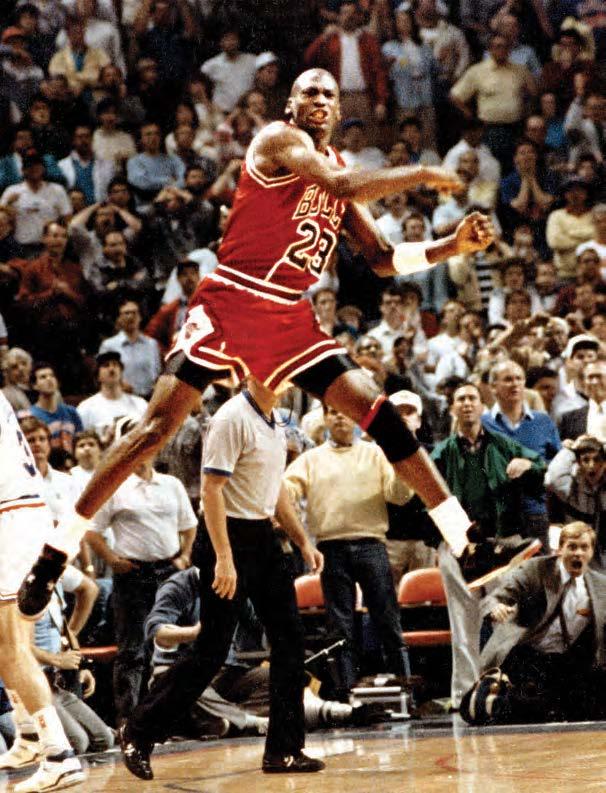
Cubs vs. White Sox; and Northwestern University’s Kellogg vs. University of Chicago’s Booth. But one area where there’s no dispute is our shared love for Chicago and all it can offer. We’re growing, right here, in the city we
love. We see a new generation of civic leaders emerging to tackle Chicago’s challenges and build a stronger future together. It’s the tough times that expose the true believers — and, like Jordan, we’ll prove the naysayers wrong.
e Windy City’s superpower is forging partnerships
rime rates, a persistent racial wealth gap and an a ordable housing crisis plague our city. But Chicago is more than data points and negative headlines.
We are the city that works. Our superpower is leveraging cross-sector collaborations to solve big problems and build a stronger, more inclusive city and region.

For 90 years, the Metropolitan Planning Council (MPC) has worked alongside businesses, universities, government, and other nonpro ts as a convener and catalyst for change. MPC launched a groundbreaking initiative in 2017, e Cost of Segregation, showing that the Chicago region loses $4.4 billion in additional income each year and has a 30% higher homicide rate because of segregation. e ndings brought together diverse communities and sectors to develop solutions to these entrenched problems.
Similarly, We Rise Together was formed in response to concerns about economic recovery in Black and Latinx communities after
the pandemic. is initiative connects philanthropic, business, community, nonpro t, and local government leaders to drive neighborhood investment, strengthen businesses and increase access to jobs. e work is done through grantmaking, promoting inclusive business practices in hiring and addressing public policy barriers to services and bene ts.
Since its launch in 2021, We Rise Together has invested $30 million in 35 development projects on the South and West sides of the city, provided exible funding to close the capital gap for Black and Latinx business owners, and worked to ease red tape in government processes for development and services.
During the pandemic, we learned that transit agencies in northeastern Illinois were heading toward a scal cli , with an expected budget shortfall of $730 million in 2026. Civic, government, community and business leaders drafted the Plan of Action for Regional Transit (PART), which includes a bold vision to ensure the nancial

viability of the transit system.
Submitted to Gov. J.B. Pritzker and the General Assembly in December 2023, PART recommends strengthening how we fund public
transit; improving the rider experience; streamlining governance of the Chicago Transit Authority, Metra and Pace; and focusing on equitable development near tran-
sit to address socioeconomic gaps in communities. It is now up to state lawmakers to act on these recommendations.
Crime rates jumped 16% last year and are up 55% since 2019. In response, the Civic Committee of the Commercial Club of Chicago formed the Public Safety Task Force, bringing together business leaders, community-based organizations and philanthropic partners to make Chicago the safest big city in America. e committee set veyear goals to achieve this bold vision through hiring, scaling existing community violence intervention programs, and providing organizational support to the Chicago Police Department and community-based organizations. One key goal is to reduce shootings and homicides by 50% in ve years and 75% in a decade. To date, the Civic Committee has raised $66 million to combat crime in Chicago.
Decades-long problems cannot be xed overnight by a single organization, leader or agency. Partnerships with purpose and clear objectives are key to creating a safe and prosperous region. Collaboration will strengthen our region so that everyone has an opportunity to thrive.
18 | CRAIN’S CHICAGO BUSINESS | FEBRUARY 26, 2024 CRAIN’S REBRANDING CHICAGO | COMMENTARY
Darlene Hightower is president and CEO of the Metropolitan Planning Council.
JOHN R. BOEHM
The Chicago Bulls’ Michael Jordan reacts after hitting the game-winning basket over Cleveland’s Craig Ehlo, left rear, in Game 5 of the NBA playoffs May 7, 1989, in Cleveland. | AP IMAGES
Civic, government, community and business leaders drafted the Plan of Action for Regional Transit (PART), which includes a bold vision to ensure the nancial viability of the transit system. | JOHN R. BOEHM
What Chicago’s peer cities have going for them
A host of characteristics make cities vibrant, desirable and high-pro le. No one has everything, but some have more than others. Here are cities Crain’s staff deemed to be comparable in some ways to Chicago.








ECONOMY
Gross domestic product by county (2022)
Poverty rate (2022)
EDUCATION
Percentage of population with a bachelor’s degree (2018-2022)
Number
Of
Today’s version of the ‘City of Big Shoulders’
“Chicago is such a great city, I love it,” is what I so often hear when I travel. I also hear comments about the crime, the corruption and the entrenched inequalities.
In 1914, Carl Sandburg, in his poem "Chicago," illustrated the juxtaposition of Chicago’s greatness with its brutality. “On the faces of women and children I have seen the marks of wanton hunger.” But in response to the “sneer at this my city,” he adds, “Come and show me another city with lifted head singing so proud to be alive and coarse and strong and cunning.”

decimated manufacturing sector. Many say companies left because of the nearly singular focus on shareholder value. ey just up and left, and with them the vibrancy of Chicago’s workforce and neighborhoods. Given these conditions, which amazingly persist to a large degree, we cannot be surprised by the attendant social problems.
When you love Chicago as much as so many of us do, you feel proud and you feel pride for its history, including the industrial history about which Sandburg wrote.
But “pride comes before a fall.” It is not that we were arrogant about our industrial past, but in Chicago, like other “rust belt” cities, factory after factory was closed — often without much notice. Left behind were high rates of unemployment, disinvested neighborhoods, contaminated sites, and a
In 1950, the city of Chicago had 668,000 manufacturing jobs. In 2022, there were 63,000. Manufacturing is an economic base sector with the biggest multiplier e ects. Manufacturing jobs, besides producing goods, produce even more jobs. During this same period, the city’s population went from 3.7 million people in 1950 to just over 2.7 million people today — a drop of 1,000,000 people. With the dramatic decline of an export-based economic sector and a parallel loss of population, we cannot be surprised that we do not have an adequate tax base to support the necessary infrastructure and public services, let alone service needs created by

these conditions.
If Chicago wants to be a global leader, it is not by wantonly opening our city to bad economic policies while sacri cing segments of the population or environment to do so. A global leader is de ned by how well it meets the basic needs of its residents — food, water, shelter, education and healthcare. Economic vitality and shared prosperity do not need to be mutually exclusive.
One thing we know for sure, a
prevalence of low-wage jobs, unavailable or una ordable housing, higher property taxes, and pushing longtime residents out of neighborhoods through gentri cation will not restore the greatness of Chicago. Bringing back contaminating industry is not the answer either. Where is the opportunity for Chicago to lead the pack? What is today’s version of the “City of Big Shoulders?” A city of solutions for today’s most urgent issues?
ere are visionaries among us
who believe that we can become a global leader in the production of goods needed for the emerging economies around green manufacturing, renewable energy, local food production and more. ere is enough research and economic analysis now to demonstrate both the urgency for this direction as well as the economic feasibility.
Helping to decarbonize the planet is a viable path to provide signi cant economic opportunities at a scale that could reinvigorate an economic base sector, provide decent and livable wages, add to the tax base, and provide local capital to invest in neighborhoods.
e Method plant, a $39 million facility in the Pullman area, is a good example, but there is so much more that is possible. Illinois state legislation like the Climate and Equitable Jobs Act (CEJA) is a good start to what needs to be a concerted and ongoing e ort so that Chicago again is the among the brightest stars in the urban stratosphere.
I look forward to saying to those who “sneer at this my city and say to them, come and show me another city with lifted head singing so proud to be alive and coarse and strong and cunning.”
FEBRUARY 26, 2024 | CRAIN’S CHICAGO BUSINESS | 19 REBRANDING CHICAGO CRAIN’S
Teresa Córdova is director of the Great Cities Institute at the University of Illinois Chicago.
The Method plant in the Pullman area. | WTTW NEWS
ChicagoDallasHoustonMiamiLos AngelesNew YorkBostonSan Francisco TRANSIT Boarded ight passengers (2022) 33,114,058 35,345,122 19,813,054 23,946,445 32,323,36514,367,438*17,443,38220,411,222 Commute time average
COMPANIES
of Fortune 500 companies (2023)
ce rent
space, per square foot)
CONVENTION CENTER Total space rank Hotel availability rank 34.4 minutes $417.6 billion (Cook) 16.9% 42.4% 25 $41.24 McCormick Place #1 #20 26.9 minutes $299.8 billion (Dallas) 17.5% 36.5% 20 $35.89 Kay Bailey Hutchison Convention Center #26 #12 27.5 minutes $402.8 billion (Harris) 19.6% 35.2% 22 $39.47 George R. Brown Convention Center #17 #3 28 minutes $184.5 billion (Miami-Dade) 20% 34.2% 5 $58.23 Miami Beach Convention Center #24 #27 31.6 minutes $790 billion (Los Angeles) 17.1% 36.7% 5 $47.39 Los Angeles Convention Center #30 #5 41.4 minutes $781 billion 17% 40.2% 65 $86.34 Jacob K. Javits Convention Center #5 #2 30.6 minutes $152 billion (Suffolk) 17.5% 53.4% 9 $52.48 Boston Convention & Exhibition Center #14 #4 32.8 minutes $234 billion 10.5% 59.8% 19 $72.38 George R. Moscone Convention Center #27 #10
(Class A
in Q1 2024
Sources: U.S. Department of Transportation;
Data USA; Bureau of Economic Analysis; Fortune.com; Boyd Co.; BizCosts; The Wall Street Journal; CBREResearch. Note: *LaGuardia Airport
Chicago can recover from its ‘reputational hit’
In some ways, the city fell victim to a political narrative, an urban planning expert says
Crain’s spoke with Richard Florida, a professor at the University of Toronto’s Rotman School of Management and an urban planning expert, about Chicago's standing and image. e conversation has been edited and condensed for clarity.
Crain’s: As somebody who pays a lot of attention to a lot of cities, what’s your take on Chicago today?
Florida: Chicago has been one of the cities that has been most challenged by the pandemic and its aftermath. Like New York or San Francisco, it has a downtown that was a massive employment center. . . .Add to that the fact that Chicago’s employment mix was not high tech or entertainment or the heights of banking and nance, but a more regular, normal, non-di erentiated professional, information, nance and real estate mix. . . .It’s not a capital of an industry or many industries the way San Francisco may be, or the way Boston might be in life sciences or academia, or the way New York might be in nance and real estate.
Chicago, like other cities, has had real or perceived issues with crime and safety.
at said, Chicago is a great, resilient, large American city and metro with great intellectual institutions, large companies, a big employment base. . . . Young
CHICAGO
From Page 16
ues to the suburbs,” Florida says. “ e downtown of the future has to be an entertainment center, and sports are part of that.”
He points to Detroit as an example. “Before, I would have said Detroit went too far with the casino, the stadia, the arena. . . .What we’ve learned post-COVID is that stu is necessary. In a reduced ofce environment, attractions and visitation are so key. is is what Miami and Las Vegas gured out.”
e city’s basic tourism story is strong, says Welsh, who now is president of the trade association Destinations International. “Everything you need to be successful is there,” he says of the city’s natural assets, such as location, size, accessibility, cultural institutions and amenities.
Need a bolder approach
When it comes to the message, Mark Mitten, who was chief brand o cer for Chicago's 2016 Olympic bid, says the city needs to take a bolder approach. “We’ve always been in defensive mode, trying to justify that we’re OK, rather than saying, ‘We’re exceptional, and here’s why.’"
Welsh suggests that Mayor Brandon Johnson should take the lead in selling the city. “He’s a
people have reasons to like Chicago, and the suburban areas outside Chicago are still one of the very few places in the United States that o er a ordable housing, relatively high quality of life and good schools. In the long run, Chicago will be just ne.
Has the brand taken a hit?
Yes. Two cities in particular have been picked on . . . that’s Chicago and San Francisco. I don’t think it’s the rst time Chicago has su ered a reputational hit. It’s happened before, in the late '60s, probably in the '80s as well. I don’t think it’s a lasting hit. I don’t think it’s a hit the city can’t recover from.
It’s already recovering. What you hear people say is: 'I went to Chicago and I visited, and it was great. e restaurants are great.
e nightlife is great, and I had a good time.'
Chicago has had a reputation as a city that works. Are we seen as a place that isn’t working?
What Chicago got caught up in is: In the wake of Amazon HQ2, Jeff Bezos said, 'I’m
great spokesperson for Chicago.”
Zopp, former World Business Chicago CEO, says Johnson will have to adapt to the role. “He needs to be an advocate not just for the city, but for the idea that this is a place where businesses can thrive and where they should want to be,” she says.
“It would help counter this perception that he doesn’t care about business, which I don’t think is fair," she adds. "Without a thriving business community, you won’t have resources to do the things you want to do more broadly. ey are not incompatible.”
But it will take more than Johnson’s favorite slogan that Chicago is “the greatest freakin’ city in the world.”
“E orts to reshape a narrative in the absence of a change in action amount to lighthearted PR campaigns that don’t deliver,” says William Howell, a professor at the University of Chicago’s Harris School of Public Policy.
He points to the migrant crisis.
“Our claim to be a sanctuary city was an opportunity to cut to the core to say, ‘ is isn’t just who we are but how we treat others.’ Instead, we were on our heels and remain on our heels as we deal with a crisis.
“I feel like, in so many ways, we’re on our heels — talking about 'What is the murder rate?' and asking, ‘How bad is it really?’ instead

frustrated with Seattle. I really don’t like the way they’re treating me. I don’t like that they're trying to impose a head tax on me, and I’m going to look for a second headquarters.' There was a segment of the more rightward-leaning tech community or more libertarian technology-based business community who wanted to make a statement about what they perceived as an anti-business, leftward, ‘woke’ thing that
Sweet Home, Chicago
happened in American cities.
For this group of people — many of whom relocated their business to two places, Texas and Florida — they were trying to make statements about that and say: 'Look, Chicago and New York and San Francisco are no longer as well governed. ey’ve been captured by a liberal elite.' at’s not true, and they found when they moved to Austin, Texas, and Miami, Fla., they found they’re also big cities that have
The city’s median home price is lower and has increased more slowly since the start of COVID pandemic than all but one of its peers, making the metro area more affordable.
Median single-family home price by metro area
Boston Chicago Los Angeles ..... Dallas Houston Miami San Francisco New York
Source: Red n
of leaning forward and capturing people’s imaginations and getting their investment in the city.”
He’s not the only one encouraging government leaders to go big. Derek Lindblom, who served in an economic development role during Emanuel’s rst mayoral term and now is chief operating o cer at health care startup CareBridge, also says the city needs a rallying cry.
“ e best way to turn around the rhetoric is you have to come up with big goals that people doubt you on and do it,” he says, pointing to Millennium Park and the city’s Olympic bid. “No one is challeng-
ing the community to come up with something we could all agree on. What if we picked a police district and said we’re going to rally the community and corporate community and make it the best district in the country, a model of what policing can be if it’s done right?”
Tullman says the business community also has to get more engaged. “ e mayor has to step up. Second, I think business has to step up.”
Some of Johnson’s policy initiatives — such as an increase in taxes on real estate sales over $1 million
problems with poverty and homelessness.
I think it’s overblown, but maybe they did lurch too far left. Maybe they did ignore business a little too much. And maybe it’s good they get this wake-up call. Voters are responding in many of these cities, electing more center-left politicians and demanding that o ces reopen and streets are policed and the city becomes safe. Maybe it was a needed self-correction.
at a time when commercial property owners are facing upheaval — could make that a tougher sell at home and outside Chicago.
“It makes no sense to attack business, to do these taxes that target wealthy homeowners, because the fact of the matter is they now have options,” Florida says. “With remote work, they have much more choice in where they live and work.”
Despite the challenges, Florida and others say they’re not betting against Chicago.
“ ere’s lots of bad news coming out of Chicago, but there’s no disputing it’s still an incredible city,” says Sean Conlon, an Irish immigrant who got his start as a real estate developer and investor in Chicago, but now splits his time between London and St. Croix, though he still does business in the city. He invests more in Palm Beach, Fla., Dallas and North Carolina than Chicago these days because “they’re just more open to doing business.”
“We’re not selling Chicago. We’re busy ghting with ourselves internally on politics and all these crazy things," Conlon says. "We should start selling it to the world again. (City leaders) have to get tougher on crime, and they have to be a little more pro-business. But give itself a few tweaks and it will be back competing with the best of them, because it’s a gorgeous city.”
20 | CRAIN’S CHICAGO BUSINESS | FEBRUARY 26, 2024
CRAIN’S REBRANDING CHICAGO
Richard Florida
$1.5 million $1 million $0.5 million $0 million January 2014 January 2016 January 2018 January 2020 January 2022 January 2024 January 2012

Redeeming the city’s reputation requires a communal effort
Successful rehabilitation will equalize the disconnect between image and reality
No town, city or state is perfect, including Chicago. We tend to over-focus on its aws while ignoring its strengths. Chicago is a great city, but if the rest of the country only hears about its crime, high taxes and debt, it will have a “bad” reputation. But the people who know it best, those who live here, see the whole picture and celebrate the Second City.
Changing Chicago’s image requires tamping down the real negatives while better highlighting the city’s equally authentic strengths.
According to a recent Harris Poll survey, 85% of city residents are proud to be Chicagoans. Much of their pride is rooted in the city’s unique character: Since Chicago’s 1837 founding, the city has become a vibrant mecca of art, music, dining and entertainment. Nine in 10 (85%) city residents think the greater Chicagoland area’s local cultural quirks (e.g., hot dog style, Chicago slang) make it special.
Four in ve (80%) city residents think the greater Chicagoland area has more to o er than other
major U.S. metropolitan areas. It’s easy to understand why. e Windy City has remarkable o erings, from museums to sports teams and green space. e Art Institute of Chicago holds one of the largest collections of Impressionist and Post-Impressionist paintings outside of Paris.
Chicago is one of only 11 U.S. cities with teams from all five major professional sports leagues (NFL, NBA, NHL, MLB, MLS). And the Chicago Park District is the largest municipal park manager in the country, maintaining 28 miles of lakefront and 24 beaches.
Culinary destination
Food is an important aspect of Chicago culture, and the city has evolved into a culinary destination. Chicago boasts world-class restaurants, including Michelin-starred Alinea, Smyth, Ever, Moody Tongue and Oriole. Only four U.S. cities— New York City, San Francisco, Los Angeles and Washington D.C.— host more Michelin-starred restaurants. e quality and diversity of
the dining scene isn’t limited to such elite establishments either: City residents agree that local favorites such as Portillo’s (71%), Giordano’s (65%), Garrett Popcorn (58%) and Al’s Italian Beef (56%) are also local cultural highlights. And, of course, there’s Mr. Beef, the city mainstay enjoying a renaissance as the inspiration for FX’s awardwinning series, “ e Bear.” at other local eateries are also bene ting from appearing on the show — it’s been called a “Bear E ect" — only underscores how powerful a ray of good news can be.
And yet the perception and reality of Chicago’s problems, most importantly public safety, persistently overshadow all these positives.
The two students shot and killed last month in the Loop are just the latest faces of our rolling crime tragedy. No matter how delectable the food scene or how vibrant the cultural offerings, no one is going to sample them if they are worried about getting shot. The best way to reverse that is for our political leaders, in
conjunction with the business community, to stem the crime wave. Chicago Police Superintendent Larry Snelling recently told the Economic Club that 2024 will be “probably the most challenging” year. He and Mayor Brandon Johnson must rise to that challenge or everything that makes the Second City great will remain secondary.
It's not on them alone, however. All Chicagoans are in this together and redeeming our city’s reputation will require a communal effort. at will start with political leadership seeking creative, nonpartisan solutions in partnership with the business community. And it will require help in every ward and neighborhood in the city.
Image vs. reality
Success will help equalize the clear disconnect between Chicago’s image and reality. We are more than a series of crime statistics or a tally of mounting debt. But to change its reputation as “bad” or “dysfunctional,” we must mitigate those negative facts while


William Johnson is CEO of e Harris Poll, a global public opinion polling, market research and strategy rm.
Chicago pride
Do you agree or disagree with the following statement: “I’m proud to be a Chicagoan”?
15%
85%
Source: The Harris Poll
more intentionally highlighting Chicago’s local culture, unique character and unparalleled o erings to those who do not live here. Because those of us who do live here know a di erent side of Chicago. Yes, we see the city’s aws, but we also see its beauty and experience its grandeur.
FEBRUARY 26, 2024 | CRAIN’S CHICAGO BUSINESS | 21 REBRANDING CHICAGO CRAIN’S
BRANDI ALEXANDRA/UNSPLASH
Of ce towers reshaped Chicago’s skyline. Now construction cranes are vanishing.
The dwindling number of groundbreakings are a stark turnaround for the Windy City and a sign of economic struggles as higher interest rates, in ation and weak demand for of ce space squelch appetite for new development
Isis Almeida and Miranda Davis, Bloomberg
When Rahm Emanuel ran Chicago and wanted to boast about the health of the city, the then-mayor pointed to the number of construction cranes across the skyline — 60 at the end of 2017.
Almost ve years after he left o ce, that number has dwindled to the single digits. ere was just one groundbreaking on an o ce building last year, and zero are expected in 2024.
It’s a stark turnaround for the Windy City and a sign of its economic struggles as higher interest rates, in ation and weak demand for o ce space squelch appetite for new development.
e commercial real estate crisis brought on by the rise of remote work and higher borrowing costs has sent US o ce values tumbling across the US, leading to mounting turmoil for banks and making it less appealing for lenders to o er nancing for new buildings. Construction has slowed from San Francisco to New York, where JPMorgan Chase & Co.’s new headquarters, opening in 2025, is set to be the largest ofce tower to debut for several years.
‘Of ce is toxic’
“O ce is toxic,” said Bob Clark, executive chairman and founder of developer Clayco, which moved its headquarters to Chicago about a decade ago. “A lot of people had their projects based on low interest rates, and today that actually just doesn’t pencil.”
e decline in new development is particularly steep in Chicago, where only nine cranes were operating as of August, according to the last o cial count from construction-advisory company Rider Levett Bucknall. at compared with 29 in February 2020, just before the onset of the Covid-19 pandemic. e 69% drop was more pronounced than anywhere but Manhattan among 12 major US business centers tracked by the rm.
In a city where Emanuel touted the number of cranes as a sign of “economic vitality, vibrancy and versatility,” the lack of construction presents a challenge to reviving a downtown plagued by high o ce vacancies. Mayor Brandon Johnson, nine months into the job, is confronting falling scal revenue and — like his predecessor, Lori Lightfoot — a relatively strained relationship with the business community.

tration will release additional economicdevelopment plans soon.
For now, Johnson’s main real estaterelated measure is a proposed increase in transfer tax for property deals of $1 million or more to provide funding for homeless services. e so-called “mansion tax” proposal, which will be on the ballot in March, applies to sales of both residential and commercial buildings, sparking concern among investors that it will further hurt prices.
Emanuel, now US ambassador to Japan,
In a city where Rahm Emanuel touted the number of cranes as a sign of “economic vitality, vibrancy and versatility,” the lack of construction presents a challenge to reviving a downtown plagued by high of ce vacancies.
Jason Lee, a senior adviser for Johnson, said counting cranes is a good measure of economic development, but not the only one. He pointed to corporate expansions, small-business growth, and increased cultural and entertainment revenue as examples of positive activity.
“With in ation and higher interest rates, the city now faces a di erent environment,” he said, adding that the adminis-
declined to comment for this story.
Weakness in commercial real estate has gained heightened attention this month after lenders from New York Community Bancorp to Japan’s Aozora Bank and Germany’s Deutsche Pfandbriefbank AG sparked investor concern about souring loans. e US o ce market has been hit particularly hard by falling values, with property prices declining 22% in the 12
months through January, according to real estate analytics rm Green Street.
Chicago is illustrative of the strains. Its o ce vacancy rate reached 21% at the end of last year, according to Jones Lang LaSalle Inc. O ce leasing fell 17% in the fourth quarter from 2022 levels and 53% compared with the previous three months, data from the real estate broker show. In the eastern part of the Loop, the central business district, the owners of the iconic Chicago Board of Trade building handed the keys back to lenders.
While more workers are returning to o ces — occupancy on peak weekdays is at almost 70%, the second-highest in the country, according to JLL — the uncertainty of schedules and varying plans by employers has hurt demand for space, said Brian Atkinson, managing director for Chicago at Hines.
“Is it three days a week? Is it four days a week? Is it ve days a week? Is it 100% in o ce?” he said, adding that he wouldn’t be surprised if there’s no new commercial construction announced in Chicago this year. “ at uncertainty has led to shorter commitments from actual users and a reluctance in general to make big commitments.” e o ce downturn can lter through the economy. Fewer workers mean down-
town businesses generate less sales tax revenue. Reduced commercial real estate assessments shift the property-tax burden to the city’s homeowners, threatening to reduce Chicago’s appeal to residents over the longer term. And empty streets aren’t conducive to safety. e city is already struggling with persistently high crime rates, with incidents up 55% since 2019.
‘I wouldn’t take it for free’
New buildings bring construction jobs and add a sense of vibrancy to neighborhoods that is important for both attracting tenants and luring employees back to ofces, said Alex Najem, chief executive ocer of Fulton Street Cos., the developer behind the only Chicago o ce project to break ground in 2023.
e property in Fulton Market, an area popular with tech rms, is set to be a 409,000-square-foot o ce building. Lead investor Shanna Khan, daughter of billionaire Jacksonville Jaguars owner Shahid Khan, is providing nancing along with a $230 million loan from Manulife Financial Corp. and Bank OZK.
e location, leasing activity and backing from a high-net-worth family provided con dence in the development for both lenders and the city, Najem said. He sees demand rebounding for new o ces with bespoke amenities in top locations, while older properties languish. e amount of money and work required to retro t those buildings is “literally impossible,” he said.
“People deserve to spend a majority of their life in a more exciting, more healthy environment,” Najem said. “New construction, whether it be in a business district or a neighborhood like Fulton Market, you can a ord to do that. You couldn’t pay me to take a building in the Loop. I wouldn’t take it for free.”
Other pockets of the Chicago real estate market are attracting investors. Amancio Ortega, the billionaire founder of the Zara clothing chain, bought a 45-story residential building for $232 million. Developers Shapack Partners and CRG landed an $84 million loan for a 29-story apartment tower. And a crane is operating for one prominent new building: the Obama Presidential Center, set for completion by the end of next year.
“Just because there’s a lack of new development, doesn’t mean that money isn’t being spent,” said Margie Baran, managing director for projects at JLL in Chicago. “Most of the major projects happening in Chicago right now are related to entertainment, cultural institutions, and sports.”
For the rest of Chicago’s commercial property market, returning to normal will take awhile. Hines’s Atkinson said new construction may be announced again in 2025 — meaning towers wouldn’t actually arrive until 2028 or 2029. For building to rebound, interest rates will need to come down, investors will need more certainty on the economic outlook and people will need to return to o ces in a more meaningful way, he said.
“Mayor Emanuel was counting cranes at a time of economic expansion, economic growth — we’re quite clearly going through a national slowdown,” he said. “It was a di erent economic time.”
The decline in new development is particularly steep in Chicago, where only nine cranes were operating as of August, according to the last of cial count from construction-advisory company Rider Levett Bucknall.
22 | CRAIN’S CHICAGO BUSINESS | FEBRUARY 26, 2024
THOMAS J. LINDEN
GRILL ON 21
208 S. La Salle St., Chicago, IL 60604 312-634-000 ext. 3 • grillon21.com
The best business lunch in The Loop, Grill on 21, provides a perfect setting for your most important client meetings. Our menus celebrate quality, seasonality, locality, responsibility and authenticity. Our menus seamlessly weave together well-being and luxurious indulgence for breakfast, lunch or dinner. Grill on 21 is an elevated dining experience within The LaSalle, an Autograph Collection hotel. Visit the cut above.
DOLCI AMORI
West Loop: 494 N. Milwaukee, Chicago, IL 60654 Lakeview: 3025 N. Clark St., Chicago, IL 60657 Gold Coast: 2 W. Elm St., Chicago, IL 60610 312-414-0955 • dolciamori.com
Dolci Amori, Chicago’s authentic Italian pastry shop founded by Napoli native Ciro Longobardo, blends traditional “Italian Pasticciera” and “Rosticciera.” Our top priority is always freshness and quality. Explore unique contemporary Italian pastries, pizzas, and paninis crafted by our renowned team from Italy, led by a 40-year experienced Pastry Chef.




BELLA NAPOLI
1540 N. Roselle Rd., Schaumburg, IL 60195 847-519-7555 • bellawood red.com
Bella Napoli takes inspiration from the kitchens of Naples, crafting the best wood red Neapolitan pizzas in the Chicago suburbs along with many other unique chefs’ creations, paired with an innovative cocktailing experience and entertainment. Be the rst to nd a seat at the most gorgeous marble-topped bar in the Northwest area, overlooking the patio, open kitchen and deluxe wood red oven.
ETTA
Bucktown: 1840 W. North Ave., Chicago, IL 60622 312-847-4614 • ettarestaurant.com
Elevate your private dining experience at etta. The restaurant’s relaxed ambiance creates a professional yet inviting atmosphere, complemented by a diverse menu of wood- red entrees, artisanal pizzas, handmade pasta and farm-fresh salads. Our team of attentive staff will ensure that every detail is taken care of, allowing you to enjoy your meeting, party or gathering.











FEBRUARY 26, 2024 | CRAIN’S CHICAGO BUSINESS | 23 RE GI ST ER NO W: ChicagoBusiness.com/ ForumEvent FO RU M PA RT NER S: The Future of Chicago Public Safety Larry Snelling Superintendent Chicago Police Department FEATURED SPEAKER EV ENT TO PI C MARCH 19 | 11:30AM-1:30PM THE FORUM AT 110 N. WACKER SPONSORED CONTENT From private dining to specialty steakhouses, here are options for your next business meal. CRAIN’S DINING AND ENTERTAINMENT GUIDE





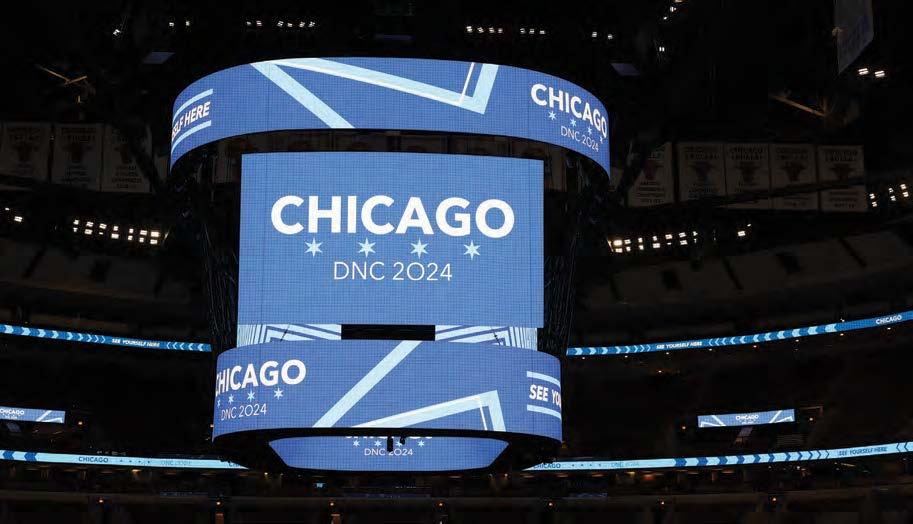
PRITZKER
From Page 1
the
Still, the governor won’t overshadow Biden since he’ll remain one of several wannabe presidential candidates stalking the convention oor, said former White House chief of sta Bill Daley.
“It’s not like this gives him some policy leg up, some money-raising leg up,” Daley said of the convention. “Unless there's some debacle that happens, the show is the president and the vice president.”
The director's chair
If Pritzker is not the star of the show, he may be its director. Two Mayor Daleys orchestrated the 1968 and 1996 conventions, one exploding in a bloody brawl between protesters and police, while the other kick-started the West Side’s revival. But as competition among New York, Chicago and Atlanta to host the DNC heated up last year, it was Illinois’ governor, rather than Chicago’s mayor, who emerged as the city’s convention quarterback.
. .I imagine that, between his own resources and his relationship with the business community, it probably gave the party some condence that the money for the convention would be raised.”
Deep history
A Chicago convention has not launched an Illinois governor's presidential campaign since 1952. At the time of the event, Gov. Adlai Stevenson had already rebu ed Democrats’ calls to headline the ticket. Stevenson refused the crown thrice before taking to the stage at the International Amphitheatre to welcome delegates. He sprinkled his speech with his signature wit and closed with a sober message delivered with Midwestern modesty. at opener whipped up the crowd and sealed his fate as the party’s nominee.
ocrats nationwide.
Current tensions
Images of giddy delegates dancing the "Macarena" in '96 still haven’t blotted out the horrors of '68, a specter that has returned to Chicago as the war in Gaza threatens to tear apart progressive and moderate Democrats. at scene played out on a smaller stage in the City Council last month, where alders split 23-23 on a nonbinding cease- re resolution.
“Any Chicago national political convention is going to be haunted by the ghost of 1968,” said Yepsen, the former SIU political analyst. “I'm sure that that very question is what's keeping Pritzker and the mayor awake at night trying to avoid this, because there's an early warning shot here in terms of Palestine.”













“ e perception is that this is the governor’s event,” said Kent Red eld, professor emeritus at the University of Illinois Spring eld. Red eld added that view persists even though much of the logistics belong to the city government and Mayor Brandon Johnson.
More recent Chicago conventions have not had the same e ect. A successful Democratic convention held no interest for Republican Gov. Jim Edgar. Even the tumultuous '68 convention appeared to have little impact on Democratic Gov. Samuel Shapiro’s political viability, in his own estimation. In a 1971 interview, historian Joe B. Frantz asked Shapiro whether the riots plagued his failed re-election campaign that followed. Shapiro couldn’t recall.
“If it had any e ect, I don't know of it,” Shapiro said.
e city has blocked permits from at least two groups seeking to protest during the convention, echoing the Daley administration’s permit denials in '68. At a small demonstration outside City Hall on Feb. 7, organizers from the Chicago Alliance Against Racist & Political Repression aimed their ire at Biden and federal authorities, but not the Illinois governor. e alliance recently paired up with Palestinian activists in Chicago to demand the cease- re resolution.

“Johnson has literally been in o ce less than a year. He does not have a strong, national presence,” Red eld noted. “ is was much more the governor’s show in terms of making the bid and trying to lay the groundwork.”
With a Republican governor in ofce in 1996, Mayor Richard M. Daley took the reins and attracted the convention to Chicago. at’s not the case with this year’s convention, with the DNC’s host city announcement coming only days after Johnson was elected mayor in 2023.
“He’s much more central to this,” former Barack Obama adviser David Axelrod said of Pritzker’s role in the convention.
Shapiro served as chairman of the rules committee at the '68 convention, but his active role centered on his decision to send the Illinois National Guard to Chicago, which he did at the request of Mayor Richard J. Daley. A phalanx formed around the DNC that summer, with 5,600 guardsmen, nearly 12,000 Chicago police o cers and 1,000 FBI agents patrolling the city. Looking back on the riots that broke out, Shapiro praised the guardsmen’s comportment, describing them as “magni cent.”
Given the city's and the Chicago Police Department’s key roles in quelling any potential civil unrest, the mayor is likely to shoulder more of the blame if events outside the convention hall go wrong. But if all goes well, the governor will likely get the credit, said Kitty Kurth, a political strategist who has worked at several conventions.
"Unfortunately, the kinds of things that can go wrong are not really in the governor’s purview, they’re in Mayor Johnson's purview,” she said. “If I had to choose, would I rather be the governor or rather be mayor?”
While the mayor and police may be on the front lines, Axelrod disagrees that the stakes are not as high for the governor.






“ e governor will be much more prominent in this convention than we've seen in Democratic conventions in recent history in Chicago,” Axelrod said. “It was clear he was a relentless lobbyist. .
In reality, the guardsmen and police did not keep their cool, as Shapiro described. During the Aug. 28 melee with protesters, they deployed tear gas into the crowd and drove boxy, barbed wire-covered Jeeps. If the turmoil had not turned the tide in Shapiro’s campaign, he at least acknowledged that the convention had dampened the spirits of Dem-
“If this thing doesn't go well, it doesn’t bene t anybody,” he said. “ e governor has a stake in how it runs. And he doesn't have as much line authority over every aspect of it, but he does have a stake in it, in part because he has put his imprimatur on it. And he's worked so hard to bring it there.”
24 | CRAIN’S CHICAGO BUSINESS | FEBRUARY 26, 2024 CLASSIFIEDS Advertising Section To place your listing, contact Suzanne Janik at (313) 446-0455 or email sjanik@crain.com .www.chicagobusiness.com/classi eds OUR READERS ARE 125% MORE LIKELY TO INFLUENCE OFFICE SPACE DECISIONS Find your next corporate tenant or leaser. Connect with Suzanne Janik at sjanik@crain.com for more information. Chicagoland’s latest business news and events. CAREER OPPORTUNITIES ChicagoBusiness.com/CareerCenter Connecting Talent with Opportunity. From top talent to top employers, Crain’s Career Center is the next step in your hiring process or job search. Get started today CAREER OPPORTUNITIES ChicagoBusiness.com AUCTIONS advertising opportunities available To advertise contact Claudia Hippel claudia.hippel@crain.com 312-659-0076 AUCTIONS advertising opportunities available To advertise contact Suzanne Janik at sjanik@crain.com (313) 446-0455 surrogate and as an established donor
to
party.
GETTY IMAGES



STADIUM
From Page 1
of what an ambitious, state-of-theart stadium could look like within city limits — though he hasn't been in any formal talks with the Bears organization about making his vision a reality.
Booth’s notion for keeping the team in Chicago is to build a genuinely urban stadium, a rarity that stacks the stadium bowl on top of its parking structure and then hides the parking under new arti cial terrain. In all, it would be about 15 stories high, but as seen in the image at the top of this story, the bottom ve stories, all parking, wouldn’t be visible from ground level.
“You can get people, shops, housing closer to the stadium,” Booth says, “get a living, active neighborhood dynamic like Wrigleyville.”
at’s something sorely lacking at the city’s three major stadiums, whose acres of parking surround them: Guaranteed Rate, United Center and Soldier Field.
“You can’t put any economic development opportunities close to any of them,” Booth says.
Ringed in wood with support buttresses made of glulam, an engineered wood product, the 80,000seat stadium would greatly reduce the carbon footprint compared to concrete and steel construction.
“It becomes an example for the 21st century about addressing global warming,” Booth says, “and it looks great. It makes people feel good to see wood as opposed to cold concrete and steel.”
e stadium would have a helium-supported dome, although it’s not seen because of the angle shown in the image.
Booth and his associate, Kevin
BOOKSTORE
From Page 3
were really missing the Chicago market,” with no stores within city limits for several years.
e bookseller closed its downtown Naperville location in January, according to local news reports. Its other Chicago-area stores are located in Skokie, Schaumburg,
HOSPITAL
From Page 3
American Healthcare Systems is appealing the state’s decision and working “diligently” to retrieve its Level II trauma center designation. Despite all the issues, Sarian was adamant Vista Medical is not in jeopardy of shutting down altogether.
“We're not going to close it,” said Sarian, adding that he plans to visit Vista Medical by the end of the month. “We’re going to ght it tooth and nail.”
Illinois’ health department stripped the hospital of the designation last week due to the “absence of essential services,” including a blood bank, anesthesia, neurology, urology or a full-time trauma coordinator, according to a statement from the Illinois Department of Public Health.



Ste es, drew the stadium sitting on one of their preferred sites, next to the Chicago River's South Branch in e 78, where it could be a neighbor of the arena the White Sox have been talking about building there. If their vision were ever to be built, one day Bears fans could skip driving and kayak down the South Branch to the game.
But the architects say the model could also work on the spot south of Soldier Field where, as Crain’s reported last week, the team would really rather be.
at site could work, Booth says, if the Bears don’t mind wrangling with Friends of the Parks, which in 2016 stood in the way of George Lucas’ proposed museum, which was slated for the same lakefront location.
Putting the stadium on public land would make it hard to comple-
Deer Park, Algonquin, Vernon Hills, Oak Brook, Bolingbrook, Geneva, Orland Park and Joliet.
Barnes & Noble is leasing the entire 26,133-square-foot space at the former Walgreens space in Wicker Park, though Flanigan said the store will likely take up about 16,000 square feet and that the bookseller is still determining whether it will take up all three oors.
IDPH’s probe into the hospital was sparked by Jennifer Banek, Lake County coroner and a nurse anesthetist who provided patient care at Vista Medical. At a Feb. 5 press conference, Banek said she brought concerns over how Vista Medical was being sta ed, and run, to the hospital's board of directors in early December.
“Over the last several months I have become increasingly concerned about what seemed to be an alarming increase in exodus of clinicians leaving Vista Medical Center,” she said. “Mine and others' observations of a shortage in supplies necessary for patient care and reports of Vista Medical Center not ful lling its nancial obligations to contracted sta ” led to her ling a complaint.
IDPH’s investigation included interviews, reviews of records and rsthand observations, Banek said, but the agency declined on
ment the sports arena with shops, entertainment venues and other revenue sources, like what the team drew up for its now-faltering Arlington Heights campus.
Three sites identi ed e architects identi ed three sites in the city where a stacked stadium could t. Besides the site in e 78, there’s a site north of the United Center, all surface parking now, and a spot on Goose Island, now “underutilized” by FedEx and CTA warehouses, Booth says. On either site, the stadium would have symbiosis with another big venue — the West Side basketball and hockey arena in one case and the planned Bally’s casino in the other.
Aerial images of all three locations are below.
Bigger than Soldier Field, with 80,000 seats compared to 61,500,
Walgreens closed its store at that location in January 2023. Located in the former Noel State Bank building, the store was known for historical features and Vitamin Vault in the building’s basement.
A Block Club Chicago article about the closure noted that since the building, which was constructed in 1919, is part of a city landmark district, the owners are required to preserve its historical
Feb. 7 to provide any of the documents to Crain’s.
Sarian concedes nancial and sta ng issues played a role in why the state stripped Vista Medical of its Level II trauma center designation, but he also said he disputes some of the accusations. He said he believes some of the issues identi ed by IDPH were “inaccurate” or incomplete assessments of circumstances at the hospital.
e health department took its concerns to the federal level when it sent a report of its ndings and allegations to CMS on Jan. 30, according to a letter CMS sent to Vista Medical CEO Bianca De lippi and reviewed by Crain’s. CMS doesn't detail exact violations in the letter, but Banek said Vista Medical was cited for two deciencies: failure to ensure appropriate providers were available and failure to have an institutional plan or budget.
the design nevertheless has no overhanging balconies. All seats are in one giant bowl.
“It’s based on the soccer stadiums I’ve seen in England,” Booth says. “ ey don’t have so many tiers where you’re sitting under a balcony.”
Booth says he hasn’t done much of a dive on what building the stadium would cost, but he notes the team already has plans to build a behemoth somewhere and has funding in mind.
“ e point is to get people thinking about doing something di erent,” Booth says. He’s not alone in pronouncing both the 1991 replacement for Comiskey Park and Soldier Field’s 2001 remodeling “disasters.”
Stacked stadiums are already out there. In Union City, N.J., the high school football eld is on the school’s roof.
features. e building’s owner is Convexity Properties, a subsidiary of Chicago-based trading rm DRW Holdings. e property was fully renovated in 2012.
e space was marketed for sublease expiring in 2037 by Shai Wolkowicki of ShaiTown Realty Group and Canvas Real Estate’s Anthony Campagni and Elan Rasansky, according to a brochure. Flanigan declined to discuss the
“We have determined that the de ciencies are so serious they constitute an immediate threat to patient health and safety,” the letter reads.
e agency said the hospital’s Medicare provider agreement will terminate Feb. 24 unless steps are taken to come into compliance with the agency’s requirements.
Access to care
Vista Medical losing its Level II trauma center designation raises concerns and questions over access to care for critical or emergent health conditions, like strokes and heart attacks. When a hospital loses or drops down in its trauma designation, ambulances will not take certain cases to that hospital, said Lake County Public Health Department Executive Director Mark P ster at the Feb. 5 press conference.
IDPH said it has been working
Hiding the parking garage under landscaping has also been done. e New York Yankees did it in 2010.
Combining the two concepts, Booth has shrunk the ground space a stadium complex would occupy, making it possible to build something that’s not isolated from its neighbors. “ ose neighbors, you want those neighbors,” Booth says. “You want the stadium to stimulate urban life.”
Chicago, he says, is the place for it. “People look to Chicago for leadership in architecture,” he says. “We can lead the way into the future.”
To that end, he says, he’s got no problem with his stadium concept never getting built. His primary goal in doing it, he says, was “getting architects o their butts to get involved in the conversation about where the Bears will go.”
terms of Barnes & Noble's lease.
e Lincoln Park location will be about 8,000 square feet and occupy a recently shuttered Urban Out tters store. e suburban stores will be located in the Village Square of Northbrook shopping center at 45 Skokie Blvd., in a former Old Navy space, and at the Prairie Market retail center at 2590 Route 34 in Oswego, in a former DSW shoe store.
with Lake County leaders and other hospitals in the area to ensure nearby residents get the services they need.
In Lake County, Advocate Condell Medical Center in Libertyville is a Level I trauma center, taking in the most urgent cases, while Northwestern's Lake Forest Hospital and Endeavor Health's Highland Park Hospital are both Level II trauma centers, P ster said.
O cials for Advocate Condell said the hospital is “committed to meeting the needs of the community and providing high quality care for the patients we serve.”
A Northwestern Medicine spokesman said its Lake Forest Hospital is still “evaluating the potential impact this will have on our ED patient volume.”
Farther away in Lake County, Advocate Good Shepherd Hospital in Barrington is also a Level II trauma center, P ster said.
26 | CRAIN’S CHICAGO BUSINESS | FEBRUARY 26, 2024
On this site in The 78, the Bears and White Sox stadiums would be next to each other in the South Loop, potentially sharing the parking hidden below the Bears facility.
Booth and Steffes picked a site on Goose Island that they believe is underutilized with warehouses, and a new stadium could join the proposed Bally’s casino in turning an old industrial area into an entertainment destination.
Another sharing opportunity would come from putting the Bears stadium and its parking where United Center patrons now park. Together the two stadiums might drive economic development in the neighborhood.
IMAGES COURTESY OF BOOTH HANSEN
Etta Collective les for Chapter 11 bankruptcy in a bid for survival
‘We hope the bleeding has stopped,’ Etta owner David Pisor tells Crain’s
The struggling Etta Collective restaurant group has filed for Chapter 11 bankruptcy protection, a move that will allow the company to continue operating its three remaining restaurants while owner David Pisor works out a plan to repay debts that have crippled the company in recent months.
At its peak, Etta Collective's portfolio spanned ve restaurants across three states, but the group abruptly closed its popular Cafe Sophie in the Gold Coast and Etta River North in January. Etta also shuttered operations at its location in Los Angeles at the end of December.
The closures came around the same time that Wintrust Bank filed a complaint in Cook County Circuit Court alleging that Pisor had defaulted on a $2.5 million loan he took out in July 2022.
“We hope the bleeding has stopped,” Pisor told Crain's. In a written statement, he characterized the Chapter 11 filing as “a proactive decision to commence this strategic reorganization process with the cooperation of our lender, who has agreed to work with us so that we can come out of this process

even stronger than before.”
Etta Bucktown, Aya Pastry and Etta Scottsdale in Arizona remain open. “We are filled
with optimism about the future,” the company wrote in a letter addressed to customers. Announced expansion plans
Etta's recent struggles emerged just months after the group announced plans to expand in 2024 with new restaurants in Evanston and Dallas, as well as a second spot in Los Angeles.
Pisor was also a co-founder of Maple & Ash, considered one of the most successful restaurants in the city. But he and co-founder Jim Lasky had a falling-out a few years ago, and the two landed in a 10-month-long court battle that eventually led them to divvy up their nationwide restaurant portfolio.
Pisor took ownership of the Etta brand and Cafe Sophie, while Lasky retained ownership of the Gold Coast steakhouse and several other restaurants.
“When I took the assets out of the contentious divorce with my ex-partner, there were a lot of problems that were contained in the assets that I didn't know about,” Pisor told Crain's in January. He drew a connection between lingering issues with the Maple & Ash breakup and Etta's current struggles without going into the specifics.
Bally’s on track to open new casino in 2026
The company expects to make $50 million a year from the temporary casino at Medinah Temple
Bally’s says it’s going to start demolition of the former Tribune printing plant in July to make way for a permanent Chicago casino that will take more than 18 months to build.
e gambling company told analysts Feb. 21 that it expects to open the new casino in the third quarter of 2026, despite a recent change in the hotel component of the facility because of water pipes underground.
“We are fully dedicated to our partnership with the city of Chicago,” George Papanier, the company’s president, told analysts. “We are here to stay.”
He said the change in plans regarding the hotel hasn’t delayed the timeline for the project, which includes a casino, a 3,000-seat entertainment venue, various dining and retail establishments, a multilevel parking garage and a riverwalk.
In need of nancing
Bally’s, which also is pursuing major projects in Las Vegas and New York, hasn’t yet lined upnancing for the $1.1 billion construction of the casino along the

Chicago River. “We don’t have a commitment in place to tell you about,” said Charlie Diao, senior vice president of nance. “We are con dent of our ability to nance the project. “We don’t get access to the site until July 4. We’re going to
spend the back half of the year doing demolition and site prep. e bulk of the (capital expense) is in 2025 and 2026.”
Bally’s says the temporary casino, which opened last fall, is performing well. e company says it expects to make about $50 million
a year from the temporary facility at Medinah Temple, which cost $70 million to build. As for the much larger permanent home, which will cost at least $1.4 billion in construction and land expenses, “We expect to get all our money back and more,” Diao said.
ChicagoBusiness.com
President and CEO
Editor Ann Dwyer
Managing editor
Director, visual media
Creative director
Director of
and engagement Elizabeth Couch
Assistant managing editor/special projects
Ann R. Weiler
Assistant managing editor/news features
Cassandra West
Deputy digital editor
Associate creative director
Digital design editor
Art directors
Kayla Byler, Carolyn
Copy editors
McGregor
Todd J. Behme,Beth Jachman, Tanya Meyer
Political columnist Greg Hinz
Notables coordinator Ashley Maahs
Newsroom (312) 649-5200 or
SENIOR REPORTERS
Ally Marotti, John Pletz, Dennis Rodkin REPORTERS
Katherine Davis, Brandon Dupré, Danny Ecker, Leigh Giangreco, Jack Grieve, Rachel Herzog, Corli Jay, Justin Laurence, Steven R. Strahler, Mark Weinraub
Researcher Sophie H. Rodgers
ADVERTISING
Senior vice president of sales Susan Jacobs (312) 649-5492 or susan.jacobs@crain.com
Sales director Christine Rozmanich (312) 649-5446 or crozmanich@crain.com
Events specialist Kaari Kafer
Account executives
Linda Gamber, Claudia Hippel, Menia Pappas, Bridget Sevcik, Laura Warren
Sales administration manager Brittany Brown
People on the Move manager Debora Stein
Classi ed sales Suzanne Janik, (313) 446-0455 or sjanik@crain.com
CRAIN’S CONTENT STUDIO
Senior director of Crain’s Content Studio Kristin Bull, (313) 446-1608 or kbull@crain.com
Crain’s Content Studio manager Jordan Dziura
Custom content coordinator Allison Russotto
PRODUCTION
Vice president, product Kevin Skaggs
Product manager Tim Simpson
Production manager David Adair
CUSTOMER SERVICE
(877) 812-1590

FEBRUARY 26, 2024 | CRAIN’S CHICAGO BUSINESS | 27 Crain’s Chicago Business is published by Crain Communications Inc. Chairman Keith E. Crain Vice chairman Mary Kay Crain President and CEO KC Crain Senior executive VP Chris Crain Chief Financial Of cer Robert Recchia G.D. Crain Jr. Founder (1885-1973) Mrs. G.D. Crain Jr. Chairman (1911-1996) Editorial & Business Of ces 130 E Randolph St., Suite 3200, Chicago, IL 60601 (312) 649-5200
KC Crain Group
Jim
(312) 397-5503 or jkirk@crain.com
publisher
Kirk,
Aly
Brumback
Stephanie
Swearngin
Thomas
J. Linden
audience
Robert Garcia
Karen Freese Zane
Jason
McClain, Joanna Metzger
editor@chicagobusiness.com
Reprints (212) 210-0707 Vol. 47, No. 8 Crain’s Chicago Business (ISSN 0149-6956) is published weekly, except for the rst week of January, July and the last week of December, at 130 E.Randolph St., Suite 3200, Chicago, IL 60601-6201. Periodicals postage paid at Chicago, Ill. Printed in the U.S. © Entire contents copyright 2024 by Crain Communications Inc. All rights reserved. Reproduction or use of editorial content in any manner without permission is prohibited. Subscribe: $169 a year • Premium Print + Digital Subscription • Print delivery of Crain’s Chicago Business • Unlimited basic digital article access across all devices • Access to archived articles • Editorially curated newsletters For subscription information and delivery concerns please email customerservice@chicagobusiness.com or call 877-812-1590 (in the U.S. and Canada) or 313-446-0450 (all other locations). Postmaster: Send address changes to Crain’s Chicago Business, 1155 Gratiot Ave., Detroit, MI 48207-2732. Four weeks’ notice required for change of address.
Jack Grieve
Etta Bucktown, previously unaffected by the company’s recent woes, is now included in the latest Chapter 11 ling. | ETTA PHOTO
John Pletz
One of the latest architectural renderings of Bally’s proposed casino site at the Tribune Publishing property. | GENSLER












































































































































































































